
How 14 land grant colleges took 8.2 million acres from 123 Indigenous nations P.11



How 14 land grant colleges took 8.2 million acres from 123 Indigenous nations P.11

February 1 - 29
February 1 - 29
ENTER SUBMISSIONS at: sfreporter.com/contests
DEADLINE:
Midnight on February 29,2024
There is NO minimum or maximum word count. Entries must be typed and previously unpublished.
There is NO limit on the number of entries per poet, but each entry should be a single poem.
Winners will be published in SFR and at sfreporter.com, along with a biographical statement about the author.
QUESTIONS? Contact Julie Ann Grimm at 505.988.7530 or editor@sfreporter.com
guest Fe
Special thanks to Special thanks to guest judge Santa Fe guest judge Santa Fe Poet Laureate Poet Laureate Tommy Archuleta! Tommy Archuleta!

OPINION 4
NEWS
7 DAYS, CLAYTOONZ AND THIS MODERN WORLD 6
RUST ON TRIAL 9
DAs armorer faces involuntary manslaughter charges for movie-set death, some testimony focuses on Alec Baldwin’s role
COVER STORY 11
MISPLACED TRUST
How 14 land grant colleges took 8.2 million acres from 123 Indigenous nations

This year, the Santa Fe Reporter celebrates its 50th birthday! A free weekly print edition and daily web updates remain the core mission. Can you help local journalism for the next 50? Learn more at sfreporter.com/friends

Instagram: @sfreporter
SFR PICKS 17
Kathleen Smith sends up the songwriter signal, Turner Caroll says, “Baddies only,” remembering Robert Daughters and a little bit of the old indie-pop from hither and thither
THE CALENDAR 18
The closer we get to springtime, the more things start to go down around here
3 QUESTIONS 22
With author/educator Amy Wong Hope
A&C 27
THE BOOKSHELF
Deborah Jackson Taffa got a dang NEA grant to complete her first memoir, Whiskey Tender MOVIES 28
THE SWEET EAST
Sean Price Williams’ debut feature film points out there sure are a lot of weirdos out there
www.SFReporter.com
Phone: (505) 988-5541
Mail: PO BOX 4910 SANTA FE, NM 87502
EDITOR AND PUBLISHER
JULIE ANN GRIMM
ADVERTISING DIRECTOR
ROBYN DESJARDINS
ART DIRECTOR
ANSON STEVENS-BOLLEN
CULTURE EDITOR
ALEX DE VORE
SENIOR CORRESPONDENT
JULIA GOLDBERG
STAFF WRITERS
EVAN CHANDLER
MO CHARNOT
EDITORIAL INTERN
ADAM FERGUSON
CLASSIFIEDS ACCOUNT
EXECUTIVE
ZOE WHITTLE
DIGITAL SERVICES MANAGER
BRIANNA KIRKLAND
CIRCULATION MANAGER
ANDY BRAMBLE
OWNERSHIP
CITY OF ROSES NEWSPAPER CO.
PRINTER THE NEW MEXICAN

EDITORIAL DEPT: editor@sfreporter.com
CULTURE EVENTS: calendar@sfreporter.com
DISPLAY ADVERTISING: advertising@sfreporter.com
CLASSIFIEDS: classy@sfreporter.com
THOUGH THE SANTA FE REPORTER IS FREE, PLEASE TAKE JUST ONE COPY. ANYONE REMOVING PAPERS IN BULK FROM OUR DISTRIBUTION POINTS WILL BE PROSECUTED TO THE FULL EXTENT OF THE LAW. SANTA FE REPORTER, ISSN #0744-477X, IS PUBLISHED EVERY WEDNESDAY, 52 WEEKS EACH YEAR. DIGITAL EDITIONS ARE
FREE AT SFREPORTER.COM. CONTENTS © 2024 SANTA FE REPORTER ALL RIGHTS
RESERVED. MATERIAL MAY NOT BE REPRODUCED WITHOUT WRITTEN PERMISSION.
association of alternative newsmedia




Mail letters to PO Box 4910, Santa Fe, NM 87502; or email them to editor@sfreporter.com. Letters (no more than 200 words) should refer to specific articles in the Reporter. Letters will be edited for space and clarity.
DEEPLY RESENT LABEL
As a Jewish protester involved in the action outside the Matisyahu concert on Feb. 14, I want to set the record straight. This protest had nothing to do with antisemitism and everything to do with calling attention to the artist’s history of support for the genocidal actions of the Israeli Defense Force. Many of us, myself included, have relatives who survived the Holocaust. We deeply resent being called antisemites and are saddened at the refusal to hear the many, many anti-Zionist Jewish voices that exist in this city and country.
Second, I want to address the idea that we are somehow policing thought. From the Birmingham lunch counter sit-ins to South African apartheid, highlighting businesses, public figures and, yes, artists, who support abhorrent views is a time-honored tool of movements for rights and justice. This is not about limiting ideas. In fact, it is the opposite: an important tool allowing all of us to think critically about those who engage in politics while pretending to “just” be making art or to “just” be doing business. When an artist plays for an occupying army, they enter politics. They should expect politics in return.
TERESA DAVIS SANTA FEThe article raises the question of whether criticism of Israel is the same as antisemitism. The answer is “No.” These are two separate phenomena and should not be conflated.
The call for Meow Wolf to cancel the performance of the musician Matisyahu, came from a coalition of Santa Feans, including Jewish Santa Feans. The issue was not that Matisyahu was Jewish; the issue was Matisyahu’s support for genocide against the Palestinians in Gaza. In an interview with Newsweek (Jan. 24), Matisyahu clearly articulated his belief that whoever advocates equal citizenship for Israelis and Palestinians should be destroyed: “I would like to see any terrorist, Hamas, or person who believes Israel has no right to exist or the Jews have no right to it, I would like Israel [to] destroy those people.” Nonetheless, the New Mexico Jewish Community Relations Coalition portrayed Matisyahu simply as “a Jew with an affinity towards Israel.” This is hardly an accurate portrayal of the musician’s harsh views. True antisemitism represents a dangerous threat to us all. It should not be conflated with legitimate criticism of Israel and its genocidal enablers.
I’ve been speaking out for Palestinian rights (and have been an ex-Zionist) ever since I lived near the West Bank before, during and after the Yom Kippur War. But why do all the progressive and Wokesters shouting for “Free Palestine” silently condone Hamas’ and the majority of Mideast Muslims’ absolutely gynophobic culture of female genital mutilation (explaining all the rape and genital mutilation of Israeli women they won’t even admit to, on Oct. 7), and honor killings (OK, “liberal” families merely disown girls who date or marry un-pre-approved guys, or who don’t pass the periodic intact hymen exams)…I’m just sayin’…everybody over there is beyond crazy with generations (2,000 years’ worth, in the Jews’ case) of historical PTSD. And I don’t say what I do from Zionist propaganda, either…I was friends with Palestinian teens, as well as Israelis, back then and heard a lot more outrageous stuff than the above. Yes, it’s way past time for the Israelis to stop the horror, but it’s also time for the
“progressives” to stop cherry-picking their targets for righteous indignation. Everybody over there needs to grow the bleep up and stop sacrificing to their gods of vengeance.
REBEKAH LEVY SANTA FEMatisyahu and his followers accused the protestors at Meow Wolf of being antisemitic and against artistic expression. As one of the protestors, I’ll share our true intentions with your readers:
If an openly antisemitic performer came to Santa Fe, we would not sit idly by and let them have their “artistic expression.” Anti-racists would show up in droves to speak out and take a stand against blatant antisemitism! Why should it be different with Palestinians? That was our motivation.
Matisyahu is openly anti-Palestinian, refers to all Gazans as Hamas and wants them “destroyed.” He uses racist tropes against them, while telling the world he wants peace and has “compassion” for Gazans.
We went expecting to raise awareness among the concert-goers of how Matisyahu is profiting off political hate speech. We were unaware the show was canceled until we arrived ready to leaflet and talk to the concert-goers.
Those accusing us of antisemitism fail to recognize that a majority of protestors were Jewish. We follow our ancestors’, including Abraham Heschel’s, beliefs that we must stand up for all oppressed peoples as if they were us. Our liberation, safety and security is tied into Palestinians’ freedom, equality, safety and security.
GAILE HERLING
SANTA FE
Thank you, Alex De Vore, Meow Wolf, and SFR. Matisyahu preaches racist hate and incites violence against Palestinians. He gives free concerts to IDF soldiers as they head out to commit atrocities in the occupied territories. These are not reggae values.
Predictably, Meow Wolf is now being accused of antisemitism and censorship. Standing up against hate speech is not censorship; nor is it antisemitic. Pushback is the natural consequence of hate speech. The trending practice of equating criticism of Israeli state genocide and its supporters with antisemitism is as dangerous as its ridiculous. It obscures the very real antisemitism of neo-Nazis marching through our cities and murdering Jews in synagogues.
Matisyahu’s support for genocide has nothing to do with his being Jewish, and assuming that the two are related is itself antisemitic. The smearing of anti-genocide activists as antisemitic is a deliberate smokescreen to obscure the fact that the resistance to Israel’s genocide of the Palestinian people
is largely organized and supported by Jewish activists, here in Santa Fe and throughout the US. The antisemitism smear was enacted because the well-funded pro-genocide campaign has no legitimate facts to stand on.
CATE MOSES
SANTA FEWe call upon Meow Wolf to fire those who caused the show to be canceled, and to host an evening of celebration for the Jewish community to show they don’t tolerate antisemitism.
RABBI BEREL LEVERTOV SANTA FE JEWISH CENTERWhat an absolute joke this town has turned into. Here we are supposed to be upholding creatives and instead we are censoring them because of their religion and political beliefs. The same people who are running the pro-pally rallies in Santa Fe have undoubtedly rubbed shoulders with some very transphobic Muslims but that doesn’t phase them— only a Jewish transphobe does.
LIV OROVICH
SANTA FEThe more we support censorship of art the more over time it will become normalized… then one day something you are passionate about will be seen as offensive or wrong by “other” and that is how freedom of speech slowly dissolves into oblivion and we have a censored society.
Quick question: Are we also not baking cakes for gay people and making Black people use the back entrance again? How far back do we want to roll human and civil rights in New Mexico…or is this just for Jews?
MARA RADEN VIA INSTAGRAMThank you to the people who showed up for the actions, and those at Meow Wolf who contributed to canceling musician Matisyahu. My father was a Jewish refugee from the Nazis in 1940. I view what the Israeli government and those who profess extreme Zionism are enacting as the actions and beliefs of trauma survivors who are perpetrating their trauma on another people. The persecution of Jews through centuries wherever that occurred—in early Diaspora, the Inquisition, pogroms, the Holocaust—has
clearly created enough residual trauma that the Israeli government can hold people in its thrall through fear, and smokescreen what has been happening all along for Palestinians. Gaza is like Vietnam was for Americans until the veterans, the medics, the journalists and Vietnamese came into light with photographs, filming, honest sharing of their experiences, their wounds and their visible and invisible trauma. Are Americans blind to what happened in 1948 with the formation of Israel because that’s what happened here? Colonization and genocide cannot be disguised forever. Without knowing how it will be reconciled here, I say it’s an international war crime to be recognized as such, and come to a stop in the world. The ongoing merry-go-round of unnecessary pain, suffering and revenge is a choice. People who want to see that keep going don’t have to be welcomed in the name of “Free Speech.” Freedom expresses best on a carrier wave of responsibility. It’s not responsible to advocate falsehoods, prejudice, brutality or killing.
LOLAMOONFROG
SANTA FE
This shouldn’t have happened. The worst thing we can do as a society is silence people. Meow Wolf and these protesters are not acting inclusive and simply over-simplifying a dynamic, nuanced conversation. All this did was fuel the hate. A loving thing to do would have been to let him perform. It’s saddening to see this happening in my community. I’m disheartened and disgusted.
CHERYL CASDEN CARPENTER VIA INSTAGRAMNot shocked in the slightest to see intolerance and antisemitism is alive and well in Santa Fe. The city has built itself around artistic expression but only if that expression is a 100% approved message.
DALE WEAVER
VIA TWITTER @SINKLARD
Thank you for the stimulating OP-ED about public K-12 education in New Mexico. As an economist, I conducted a time-motion study of a leading public school and discovered:
1. The USA Federal Government spends almost nothing on public, K-12 education.
2. State governments do not fund public education as mandated by state constitutions.
3. Excellent teachers are poorly supported and too often exit the profession.
4. Home based, pre-school reading dramatically improves K-12 success and graduation.
5. Standardized testing discriminates against students and blocks teaching to many.
6. Hostile environments of poor food, no recess and public pressure hinder learning.
Thank you for your interest in making New Mexico a great place to be a kid.
BILL KERREYSANTA FE


A caption in last week’s cover package on the SFR Photo Contest winners gave the wrong caption for a photo of tiles depicting the Virgin of Guadalupe. The photo, “Lupita on Alameda,” by Nancy Egan, was taken near Galisteo and Alameda.


SFR will correct factual errors online and in print. Please let us know if we make a mistake: editor@sfreporter.com or 988-7530.
“Hi, Mom. I’m still at the library”
—Overheard from a preteen answering her phone inside Forever 21 at Santa Fe Place mall.
“I don’t want to do her; I just want to be her.”
—Overheard at La Reina
Send your Overheard in Santa Fe tidbits to: eavesdropper@sfreporter.com
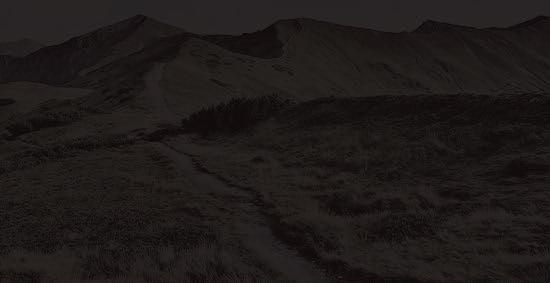


MEDIA DESCENDS UPON SANTA FE FOR FIRST RUST TRIAL
“I saw a sea of blonde broadcast ladies emerge from a van,” someone told us.

PLAZA HOLIDAY LIGHTS TO COME DOWN
Now what’ll we look at down there? The box surrounding the remains of the obelisk?!?

OINK!
LOCAL TIKTOKER QUESTIONED AFTER WEARING POLICE UNIFORM IN COMEDY VIDEO
A good use of time for everyone involved.
JUDGE RULES LAWSUIT AGAINST “MANSION TAX” CAN KEEP MOVING
Santa Fe Association of Realtors motto: Voters are bad. Mansions are good.
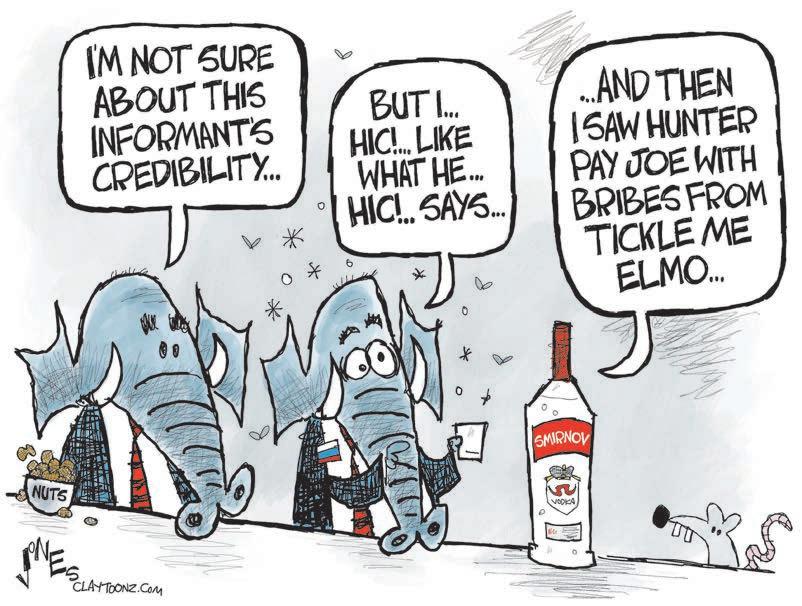
BEHIND-THE-SCENES AT THE LIBRARY EVENTS PROVIDES TOURS
Turns out there are a lot of books in there.

FOOD DEPOT HEAD SHERRY HOOPER ANNOUNCES HER RETIREMENT
No jokes about that, Sherry, we think you’re cool as hell.

SANTA FE GREENHOUSE GASES ARE DOWN, ACCORDING TO NEW REPORT
There’s a joke about chile and farting in there somewhere.

OIL AND GAS
Take a deep dive on how and why the Legislature didn’t do much to change oil and gas regulations this year.

























THE ONLY PLACE IN NORTHERN NEW MEXICO FOR CANCER RESEARCH









At CHRISTUS St. Vincent Regional Cancer Center, our dedicated team of experts provides patients with the most comprehensive cancer treatment and resources, including a sophisticated blend of clinical trials and research initiatives.




















As armorer faces involuntary manslaughter charges for movie-set death, some testimony focuses on Alec Baldwin’s role
BY EVAN CHANDLER evan@sfreporter.comAs testimony for New Mexico’s case against Rust armorer Hannah Gutierrez-Reed continues, DNA and fingerprint evidence presented in court suggests the blame could be spread around among multiple members on the production team.
Prosecutors contend that Gutierrez-Reed, who faces charges of involuntary manslaughter and evidence tampering in the shooting death of cinematographer Halyna Hutchins, was negligent in her duty to ensure prop guns and ammunition on the set were safe. Rather than using dummy ammunition as expected, she allegedly loaded a live round into the Colt-.45 revolver used by actor and producer Alec Baldwin during a rehearsal.
Baldwin maintains he did not pull the trigger before the weapon discharged, but also faces an involuntary manslaughter charge in a separate case scheduled for trial beginning July 9. Nonetheless, several hours of witness testimony have already focused on forensic analysis of the weapon Baldwin held, and his attorneys’ suggestion that the gun may have been damaged in some way.
In a status conference last week, Baldwin’s attorneys pressed for a speedy trial and indicated the state had not followed previous judge Glenn Ellington’s jury instructions when it convened the grand jury that indicted Baldwin a second time. Lawyers for the Rust actor have raised ongoing objections to the state’s handling of the case under District Attorney Mary Carmack-Altwies, who stepped down and brought on Special Prosecutors Kari Morrissey and Jason Lewis in March of 2023 after a initial special prosecutor withdrew.
Investigators sent evidence to the FBI for analysis, and some of the agency’s personnel have already taken the stand.
Jerrilyn Conway, an FBI forensics and DNA examiner, recounted to jurors on Feb. 26 how, as a case manag-
er, she reviewed serology and DNA testing of the revolver. The test, completed by a team of biologists in the FBI lab, typically refers to the identification of body fluid such as blood on items of evidence, she said.
Biologists used a reference sample from Gutierrez-Reed, Baldwin, Props Master Sarah Zachry and First Assistant Director David Halls to look for similarities in DNA between the samples and residue on the tested item. The comparison for Gutierrez-Reed, she said, was inconclusive.
However, the test did indicate Baldwin as a likely contributor, which stands to reason because he’s never contested that he held the weapon.
Later that day, however, another forensics professional said it’s clear to her GutierrezReed touched a box of ammunition that was labeled as containing only dummy rounds but actually contained a live round as well.
Shannon Prince, a physical scientist forensic examiner with the FBI, testified on Feb. 26—the third day of the trial following jury selection—and cited the difficulty of finding conclusive evidence on props like those used on the Rust set.
“There’s a very low chance of getting prints on firearms or ammunition based on size, texture and overhandling of those items,” Prince told jurors.
As a physical scientist forensic examiner with more than 19 years of experience in her field, however, she told jurors she developed 10 latent fingerprints on a box labeled “45
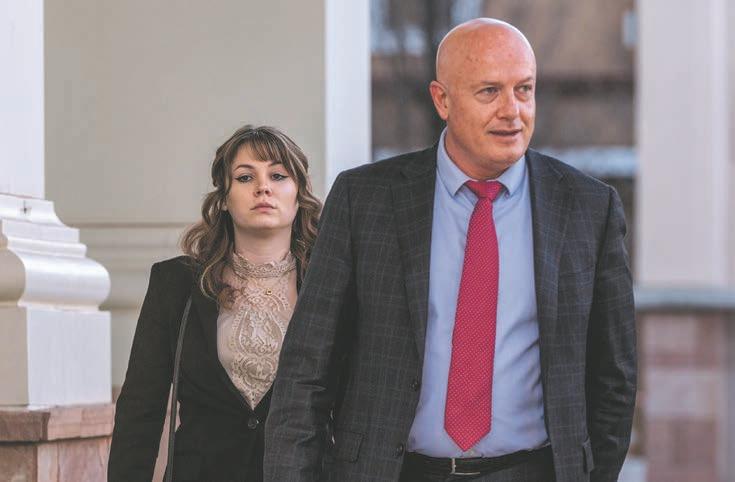
Long Colt Dummies” discovered in a prop truck on the set.
Law enforcement interviewed Seth Kenney, who supplied ammunition and guns for the film from his company PDQ Arm and Prop. Investigators also executed a search warrant on his business, but he faces no charges in the case.
Prince said two of the prints she discovered belonged to Gutierrez-Reed, while the remaining prints couldn’t be linked to Halls, Zachry or Baldwin.
Halls, who signed a plea agreement admitting to negligence use of a deadly weapon early in the investigation process, and Zachry are expected to testify on behalf of the state in Gutierrez-Reed’s case, as is Kenney.

But the fingerprint evidence also introduced some doubt into the state’s case. Tests on a second box of dummy rounds turned up three latent fingerprints. Prince said she was able to exclude Baldwin and Zachry, yet Halls and Gutierrez-Reed “were inconclusively compared to these prints.”
“There are several circumstances where you can touch an item and not leave a latent print,” she noted, such as wearing gloves; if there’s too much sweat or too little sweat on the hand; or if a surface may be dirty or textured. “There’s also environmental conditions… that could play a factor: wind or rain.”
Ross Addiego, a member of the set’s camera crew, also testified about the responsibilities
of an armorer based on his 30 years in the industry and recounted his experience within the church when the shooting occurred. He stood next to Director Joel Souza and Hutchins as the camera crew framed a shot where Baldwin was supposed to pull the Colt from a holster.
Addiego told the jury he recalled hearing the word “cold,” a typical indication that the gun on set is safe and ready to use for a scene. However, he added that he didn’t remember seeing Gutierrez-Reed on set during the “95% or more” of takes for the movie he was present for, something that was “unusual” to him.
“In my experience the armorer is never out of eyesight of whatever weapons and ammo they are in charge of,” he said, but “it was not the case” with Rust
Addiego also told jurors about several instances in which guns accidentally discharged during the less than two weeks of filming for Rust, which he complained about to higher ups in production in the early stage of filming. He filed a civil lawsuit against the Rust production company arguing it failed to follow industry safety protocol.
District Court Judge Mary Marlowe Sommer expects the trial to last until March 8. If convicted of involuntary manslaughter, Gutierrez-Reed faces up to 18 months in prison and a $5,000 fine. Prosecutors added the evidence tampering charge because another person from the movie production claims Gutierrez-Reed handed off suspected narcotics before investigators questioned her.
As of press time, 17 witnesses had testified for the state and prosecutors anticipated as many as 29 more taking the stand before their arguments are over. Watch a livestream of the trial every day at sfreporter.com
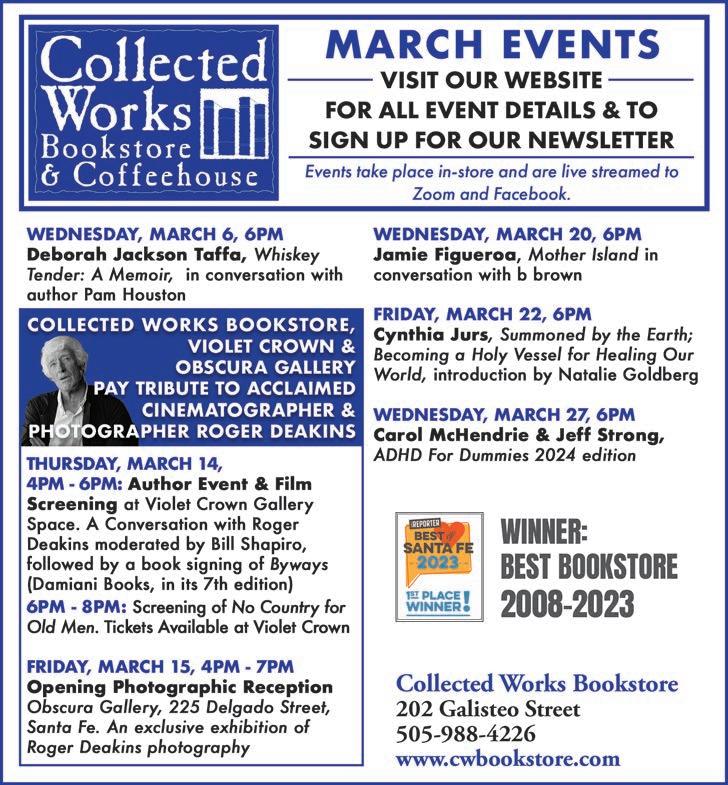



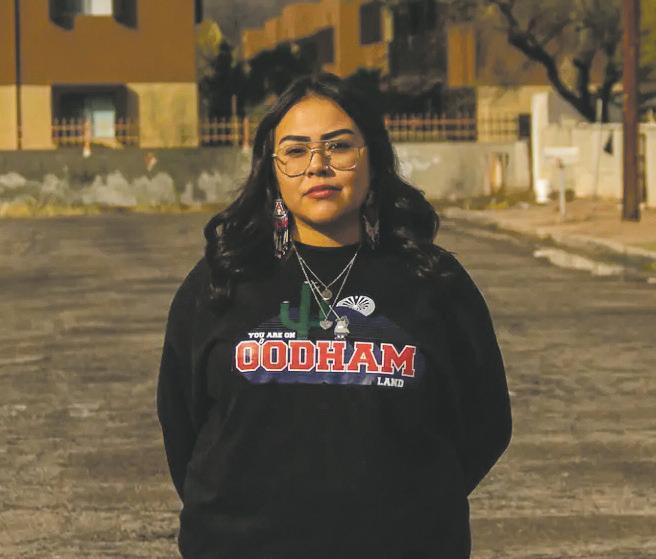 BY TRISTAN AHTONE, ROBERT LEE, AMANDA TACHINE, AN GARAGIOLA, AUDRIANNA GOODWIN, MARIA PARAZO ROSE & CLAYTON ALDERN For Grist
BY TRISTAN AHTONE, ROBERT LEE, AMANDA TACHINE, AN GARAGIOLA, AUDRIANNA GOODWIN, MARIA PARAZO ROSE & CLAYTON ALDERN For Grist
Alina Sierra needs $6,405. In 2022, the 19-year-old Tohono O’odham student was accepted to the University of Arizona, her dream school, and excited to become the first in her family to go to college.
Her godfather used to take her to the university’s campus when she was a child, and their excursions could include a stop at the
turtle pond or lunch at the student union. Her grandfather also encouraged her, saying: “You’re going to be here one day.”
“Ever since then,” said Sierra. “I wanted to go.”
Then the financial reality set in. Unable to afford housing either on or off campus, she couch-surfed her first semester. Barely able to pay for meals, she turned to the campus food pantry for hygiene products. “One week I would get soap; another week, get shampoo,” she said. Without reliable access to the internet, and with health issues and a long bus commute, her grades began to slip. She was soon on academic probation.
“I always knew it would be expensive,” said Sierra. “I just didn’t know it would be this expensive.”
She was also confused. The university, known colloquially as UArizona, expressed a lot of support for Indigenous students. It wasn’t just that the Tohono O’odham flag hung in the bookstore or that the university had a land acknowledgment reminding the community that the Tucson campus was on O’odham and Yaqui homelands. The same year she was accepted, UArizona launched a program to cover tuition and mandatory fees for undergraduates from all 22 Indigenous nations in the state. President Robert C. Robbins described the new Arizona Native Scholars Grant as a step toward fulfilling the school’s land-grant mission.
Sierra was eligible for the grant, but it didn’t cover everything. After all the application forms and paperwork, she was still left with a balance of thousands of dollars. She had no choice but to take out a loan, which she kept a secret from her family, especially her mom. “That’s the number one thing she told me: ‘Don’t get a loan,’ but I kind of had to.”
Established in 1885, almost 30 years before Arizona was a state, UArizona was one of 52 land-grant universities supported by the Morrill Act. Signed into law by President Abraham Lincoln, the act used land taken from Indigenous nations to fund a network of colleges across the fledgling United States.
By the early 20th century, grants issued under the Morrill Act had produced the modern equivalent of a half a billion dollars for land-grant institutions from the redistribution of nearly 11 million acres of Indigenous lands. While most land-grant universities ignore this colonial legacy, UArizona’s Native scholars program appeared to be an effort to exorcise it.
But the Morrill Act is only one piece of legislation that connects land expropriated from Indigenous communities to these universities.
In combination with other land-grant laws, UArizona still retains rights to nearly 687,000 acres of land—an area more than twice the size of Los Angeles. The university also has rights to another 703,000 subsurface acres, a term pertaining to oil, gas, minerals, and other resources underground. Known as trust lands, these expropriated Indigenous territories are held and managed by the state for the school’s continued benefit.
State trust lands just might be one of the best-kept public secrets in America: They exist in 21 Western and Midwestern states, totaling more than 500 million surface and subsurface acres. Those two categories, surface and subsurface, have to be kept separate because they don’t always overlap. What few have bothered to ask is just how many of those acres are funding higher education.
The parcels themselves are scattered and rural, typically uninhabited and seldom marked. Most appear undeveloped and blend
in seamlessly with surrounding landscapes. That is, when they don’t have something like logging underway or a frack pad in sight.
In 2022, the year Sierra enrolled, UArizona’s state trust lands provided the institution $7.7 million—enough to have paid the full cost of attendance for more than half of every Native undergraduate at the Tucson campus that same year. But providing free attendance to anyone is an unlikely scenario, as the school works to rein in a budget shortfall of nearly $240 million.
UArizona’s reliance on state trust land for revenue not only contradicts its commitment to recognize past injustices regarding stolen Indigenous lands, but also threatens its climate commitments. The school has pledged to reach net-zero emissions by 2040.
The parcels are managed by the Arizona State Land Department, a separate government agency that has leased portions of them to agriculture, grazing and commercial activities. But extractive industries make up a major portion of the trust land portfolio. Of the 705,000 subsurface acres that benefit UArizona, almost 645,000 are earmarked for oil and gas production. The lands were taken from at least 10 Indigenous nations, almost all of which were seized by executive order or congressional action in the wake of warfare.
Over the past year, Grist has examined publicly available data to locate trust lands associated with land-grant universities seeded by the Morrill Act. Grist found 14 universities that matched this criteria. In the process, the team identified their original sources and analyzed their ongoing uses. In all, Grist located and mapped more than 8.2 million surface and subsurface acres taken from 123 Indigenous nations. This land currently produces income for those institutions.
“Universities continue to benefit from colonization,” said Sharon Stein, an assistant professor of higher education at the University of British Columbia and a climate researcher. “It’s not just a historical fact; the actual income of the institution is subsidized by this ongoing dispossession.”
The amount of acreage under management for land-grant universities varies widely, from as little as 15,000 acres aboveground in North Dakota to more than 2.1 million belowground in Texas. Combined, Indigenous nations were paid approximately $4.3 million in today’s dollars for these lands, but in many cases, nothing was paid at all. In 2022 alone, these trust lands generated more than $2.2 billion for their schools. Between 2018 and 2022, the lands produced almost $6.7 billion. However, those figures are likely an undercount as multiple state agencies did not return requests to confirm amounts.
This work builds upon previous investigations that examined how land grabs capitalized and transformed the US univer-
sity system. The new data reveals how state trust lands continue to transfer wealth from Indigenous nations to land-grant universities more than a century after the original Morrill Act.
It also provides insight into the relationship between colonialism, higher education and climate change in the Western United States.
Nearly 25% of land-grant university trust lands are designated for either fossil fuel production or the mining of minerals, like coal and iron-rich taconite. Grazing is permitted on about a third of the land, or approximately 2.8 million surface acres. Those parcels are often coupled with subsurface rights, which means oil and gas extraction can occur underneath cattle operations, themselves often a major source of methane emissions. Timber, agriculture, and infrastructure leases—for roads or pipelines, for instance—make up much of the remaining acreage.
By contrast, renewable energy production is permitted on roughly one-quarter of 1% of
the land in our dataset. Conservation covers an even more meager 0.15%.
However, those land use statistics are likely undercounts due to the different ways states record activities. Many state agencies we contacted for this story had incomplete public information on how land was used.
“People generally are not eager to confront their own complicity in colonialism and climate change,” said Stein. “But we also have to recognize, for instance, myself as a white settler, that we are part of that system, that we are benefiting from that system, that we are actively reproducing that system every day.”
Students like Alina Sierra struggle to pay for education at a university built on her peoples’ lands and supported with their natural resources. But both current and future generations will have to live with the way trust lands are used to subsidize land-grant universities.
In December 2023, Sierra decided the cost to attend UArizona was too high and dropped out.


UArizona did not respond to a request for comment on this story.
Acreage now held in trust by states for land-grant universities is part of America’s sweeping history of real estate creation, a history rooted in Indigenous dispossession.
Trust lands in most states were clipped from the more than 1.8 billion acres that were once part of the United States’ public domain—territory claimed, colonized, and redistributed in a process that began in the 18th century and continues today.
The making of the public domain is the stuff of textbook lessons on US expansion. After consolidating states’ western land claims in the aftermath of the American Revolution, federal officials obtained a series of massive territorial acquisitions from rival imperial powers. No doubt you’ve heard of a few of these deals: They ranged from the Louisiana Purchase of 1803 to the Alaska Purchase of 1867.
Backed by the doctrine of discovery, a legal principle with religious roots that justified the seizure of lands around the world by Europeans, US claims to Indigenous territories were initially little more than projections of jurisdiction. They asserted an exclusive right to steal from Indigenous nations, divide the territory into new states, and carve it up into private property. Although Pope Francis repudiated the Catholic Church’s association with the doctrine in 2023, it remains a bedrock principle of US law.
Starting in the 1780s, federal authorities began aggressively taking Native land before surveying and selling parcels to new owners. Treaties were the preferred instrument, accompanied by a range of executive orders and congressional acts. Behind their tidy legal language and token payments lay actual or threatened violence, or the use of debts or dire conditions, such as starvation, to coerce signatures from Indigenous peoples and compel relocation.
By the 1930s, tribal landholdings in the form of reservations covered less than 2% of the United States. Most were located in places with few natural resources and more sensitive to climate change than their original homelands. When reservations proved more valuable than expected, due to the discovery of oil, for instance, outcomes could be even worse, as viewers of Killers of the Flower Moon learned last year.
The public domain once covered threefourths of what is today the United States. Federal authorities still retain about 30% of this reservoir of plundered land, most conspicuously as national parks, but also as military bases, national forests, grazing land, and more. The rest, nearly 1.3 billion acres, has been redistributed to new owners through myriad laws.
When it came to redistribution, grants of various stripes were more common than land sales. Individuals and corporate grantees— think homesteaders or railroads— were prominent recipients, but in terms of sheer acreage given, they trailed a third group: state governments.
Federal-to-state grants were immense. Cram them all together and they would comfortably cover all of Western Europe. Despite their size and ongoing financial significance, they have never attracted much attention outside of state offices and agencies responsible for managing them.
The Morrill Act, one of the best known examples of federal-to-state grants, followed a well-established path for funding state institutions. This involved handing Indigenous land to state legislatures so agencies could then manage those lands on behalf of specifically chosen beneficiaries.
Many other laws subsidized higher education by issuing grants to state or territorial governments in a similar way. The biggest of those bounties came through so-called “enabling acts” that authorized US territories to graduate to statehood.
Every new state carved out of the public domain in the contiguous United States received land grants for public institutions through their enabling acts. These grants functioned like dowries for joining the Union and funded a variety of public works and state services ranging from penitentiaries to fish hatcheries. Their main function, however, was subsidizing education.
Primary and secondary schools, or K-12 schools, were the greatest beneficiaries by far, followed by institutions of higher education. What remains of them today are referred to as trust lands. “A perpetual, multigenerational land trust for the support of the Beneficiaries and future generations” is how the Arizona State Land Department describes them.
Higher education grants were earmarked for universities, teachers colleges, mining schools, scientific schools and agricultural colleges, the latter being the means through which states that joined the Union after 1862 got their Morrill Act shares. States could separate or consolidate their benefits as they saw fit, which resulted in many grants becoming attached to Morrill Act colleges.
Originally, the land was intended to be sold to raise capital for trust funds. By the late 19th century, however, stricter requirements on sales and a more conscientious pursuit of long-term gains reduced sales in favor of short-term leasing.
The change in management strategy paid off. Many state land trusts have been operating for more than a century. In that time, they have generated rents from agriculture, grazing and recreation. As soon as they were able, managers moved into natural resource extraction, permitting oil wells, logging, mining and fracking.
Land use decisions are typically made by state land agencies or lawmakers. Of the six land-grant institutions that responded to requests for comment on this investigation, those that referenced their trust lands deferred to state agencies, making clear that they had no control over permitted activities.
State agencies likewise receive and distribute the income. As money comes in, it is either delivered directly to beneficiaries or, more commonly, diverted to permanent state trust funds, which invest the proceeds and make scheduled payouts to support select public services and institutions.
These trusts have a fiduciary obligation to generate profit for institutions, not minimize environmental damage. Although some of the permitted activities are renewable and low-impact, others are quietly stripping the land. All of them fill public coffers with proceeds derived from ill-gotten resources.
For a $10 fee last December, anyone in New Mexico could chop down a Christmas tree in a pine stand on a patch of state trust
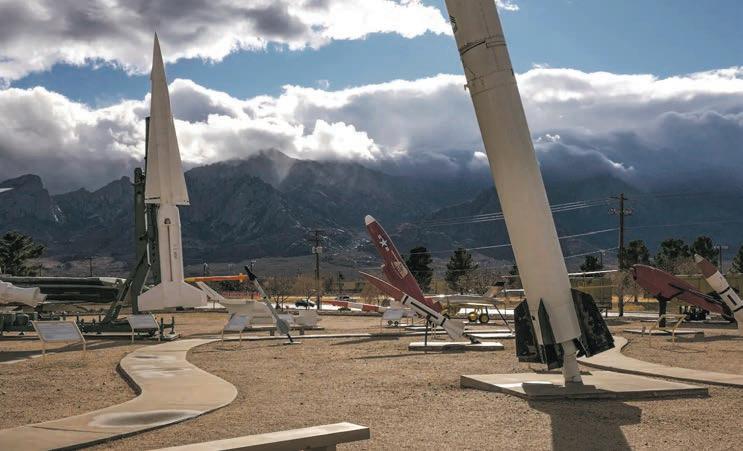
land just off Highway 120 near Black Lake, southeast of Taos. The rules: Pay your fee, bring your permit, choose a tree, and leave nothing behind but a stump less than 6 inches high.
“The holidays are a time we should be enjoying our loved ones, not worrying about the cost of providing a memorable experience for our kids,” said Commissioner of Public Lands Stephanie Garcia Richard, adding that “the nominal fee it costs for a permit will directly benefit New Mexico public schools, so it supports a good cause too.” The offer has been popular enough to keep the program running for several years.
The New Mexico State Land Office, sometimes described by state legislators as “the most powerful office you’ve never heard of,” has been a successful operation for a very long time. Since it started reporting revenue in 1900, it’s generated well over $42 billion in 2023 dollars.
All that money isn’t from Christmas trees.
For generations, oil and gas royalties have
fueled the state’s trust land revenue, with a portion of the funds designated for New Mexico State University, or NMSU, a landgrant school founded in 1888 when New Mexico was still a territory.
The oil comes from drilling in the northwestern fringe of the Permian Basin, one of the oldest targets of large-scale oil production in the United States. Corporate descendants of Standard Oil, the infamous monopoly controlled by John D. Rockefeller, were operating in the Permian as early as the 1920s. Despite being a consistent source of oil, prospects for exploitation dimmed by the late 20th century, before surging again in the 21st. Today, it’s more profitable than ever.
In recent decades, more sophisticated exploration techniques have revealed more “recoverable” fossil fuel in the Permian than previously believed. A 2018 report by the United States Geological Survey pegged the volume at 46.3 billion barrels of oil and 281 trillion cubic feet of natural gas, which made the Permian the largest oil and gas deposit in

the nation. Analysts, shocked at the sheer volume, and the money to be made, have taken to crowning the Permian the “King of Shale Oil.” Critics concerned with the climate impact of the expanding operations call it a “carbon bomb.”
As oil and gas extraction spiked, so did New Mexico’s trust land receipts. In the last 20 years, oil and gas has generated between 91% and 9% of annual trust land revenue. It broke annual all-time highs in half of those years, topping $1 billion for the first time in 2019 and reaching $2.75 billion last year. Adjusted for inflation, more than 20% of New Mexico’s trust land income since 1900 has arrived in just the last five years.
“Every dollar earned by the Land Office,” Commissioner Garcia Richard said when revenues broke the billion-dollar barrier, “is a dollar taxpayers do not have to pay to support public institutions.”
Trust land as a cost-free source of subsidies for citizens is a common framing. In 2023, Garcia Richard declared that her office had saved every New Mexico taxpayer $1,500 that year. The press release did not mention oil or gas, or Apache bands in the state. (Read a Q&A with Garcia Richard on page 15.)
Virtually all of the trust land in New Mexico, including 186,000 surface acres and 253,000 subsurface acres now benefiting NMSU, was seized from various Apache bands during the so-called Apache Wars. Often reduced to the iconic photograph of Geronimo on one knee, rifle in hand, hostilities began in 1849, and they remain the longest-running military conflict in US history, continuing until 1924.
In 2019, newly elected New Mexico Gov. Michelle Lujan Grisham began aligning state policy with “scientific consensus around climate change.” According to the state’s climate action website, New Mexico is working to tackle climate change by transitioning to clean electricity, reducing greenhouse gas emissions, supporting an economic transition from coal to clean energy, and shoring up natural resource resilience.
“New Mexico is serious about climate change— and we have to be. We are already seeing drier weather and rising temperatures,” the governor wrote on the state’s website. “This administration is committed not only to preventing global warming, but also preparing for its effects today and into the future.”
No mention was made of increasingly profitable oil and gas extraction on trust lands or their production in the Permian. In 2023, just one 240-acre parcel of land benefiting NMSU was leased for five years for $6 million.
NMSU did not respond to a request for comment on this story.
More than half of the acreage uncovered in Grist’s investigation appears in oil-rich West Texas, the equivalent of more than 3 million football fields. It benefits Texas A&M.
In the years after the Civil War, a “peace commission” pressured Comanche and Kiowa leaders for an agreement that would secure land for tribes in northern Texas and Oklahoma. Within two years, federal agents dramatically reduced the size of the resulting reservation with another treaty, triggering a decade of conflict.
The consequences were disastrous. Kiowas and Comanches lost their land to Texas and their populations collapsed. Between the 1850s and 1890s, Kiowas lost more than 60% of their people to disease and war, while Comanches lost nearly 90%.
If this general pattern of colonization and genocide was a common one, the trajectory that resulted in Texas A&M’s enormous state land trust was not.
Texas was never part of the US public domain. Its brief stint as an independent nation enabled it to enter the Union as a state, skipping territorial status completely. As a result, like the original 13 states, it claimed rights to sell or otherwise distribute all the not-yet-privatized land within its borders.
Following the broader national model, but ratcheting up the scale, Texas would allocate over 2 million acres to subsidize higher education.
Texas A&M was established to take advantage of a Morrill Act allocation of 180,000 acres, and opened its doors in 1876. The same year, Texas allocated a million acres of trust lands, followed by another million in 1883, nearly all of it on land relinquished in treaties from the mid-1860s.
Today, the Permanent University Fund derived from that land is worth nearly $34 billion. That’s thanks to oil, of course, which has been flowing from the university’s trust lands since 1923. In 2022 alone, Texas trust lands produced $2.2 billion in revenue.
The Kiowa and Comanche were ultimate-


ly paid about 2 cents per acre for their land. The Mescalero Apache received nothing.
Texas A&M did not respond to a request for comment on this story.
In states with trust lands, a reasonably comfortable buffer exists between beneficiaries, legislators, land managers and investment boards, but that hasn’t always been the case. In Minnesota’s early days, state leaders founded the University of Minnesota while also making policy that would benefit the school, binding the state’s history of genocide with the institution.
Those actions still impact Indigenous peoples in the state today while providing steady revenue streams to the university.
Henry Sibley began to amass his fortune around 1834 after only a few years in the fur trade in the territory of what would become Minnesota, rising to the role of regional manager of the American Fur Company at just 23. He moved into timber, making exclusive agreements with the Ojibwe to log along the Snake and Upper St. Croix rivers.
Sibley went on to become a major figure in a number of treaty negotiations, aiding the US in its western expansion, opening what is


now Minnesota to settlement by removing tribes. He was also a founding regent of the University of Minnesota—using his personal, political, and industry knowledge of the region to choose federal, state, and private lands for the university. Sibley and other regents used the institution as a shel corporation to speculate and move money between companies they held shares in.
In 1851, Sibley helped introduce landgrant legislation for the purpose of a territorial university, and just three days after Congress passed the bill, Minnesota’s territorial leaders established the University of Minnesota. With an eye on statehood, leaders knew more land would be granted for higher education, but first the land had to be made available.
That same year, with the help of then-territorial governor and fellow university regent Alexander Ramsey, the Dakota signed the Treaty of Traverse De Sioux, a land cession that created almost half of the state of Minnesota, and, taken with other cessions, would later net the University nearly 187,000 acres of land—an area roughly the size of Tucson.
Among the many clauses in the treaty was payment: $1.4 million would be given to the Dakota, but only after expenses. After agencies and politicians had taken their cuts, only a few thousand dollars arrived after federal agents delayed and withheld payments or substituted them for supplies that were never delivered.
The betrayal led to the Dakota War of 1862.
“The Sioux Indians of Minnesota must be exterminated or driven forever beyond the borders of the state,” said Ramsey. Sibley joined in the slaughter, leading an army of volunteers dedicated to the genocide of the Dakota people. At the end of the conflict, Ramsey ordered the mass execution of more than 300 Dakota men in December of 1862—the largest mass execution in US history.
That grisly punctuation mark at the end of the war meant a windfall for the University of Minnesota, with new lands being opened through the state’s enabling act and another federal grant that had just been passed: the Morrill Act. Within weeks of the mass execution, the university was reaping benefits thanks to the political, and military, power of Sibley and the board of regents.
Between 2018 and 2022, those lands produced more than $17 million in revenue.
Today, Sibley, Ramsey and other regents are still honored. Their names adorn parks, counties and streets, their homes memorialized for future generations. While there have been efforts to remove their names from schools and parks, Minnesota, its institutions, and many of its citizens continue to benefit from their actions.
The iron and taconite mines that owe their success to the work of these men have left lasting visual blight, water contamination from historic mine tailings and elevated rates of mesothelioma among taconite workers in Minnesota. The 1863 federal law that authorized the removal of Indigenous peoples from the region is still on the books today and has never been overturned.
Less than half of the universities featured in this story responded to requests for comment, and the National Association of State Trust Lands, the nonprofit consortium that represents trust land agencies and administrators, declined to comment. Those that did, however, highlighted the steps they were making to engage with Indigenous students and communities.
Still, investments in Indigenous communities are slow coming. Of the universities that responded to our requests, those that directly referenced how trust lands were used maintained they had no control over how they profited from the land.
And they’re correct, to some degree: States managing assets for land-grants have fiduciary, and legal, obligations to act in the institution’s best interests.
But that could give land-grant universities a right to ask why maximizing returns doesn’t factor in the value of righting past wrongs or the costs of climate change.
“We can know very well that these things are happening and that we’re part of the problem, but our desire for continuity and certainty and security override that knowledge,” said Sharon Stein of the University of British Columbia.
That knowledge, Stein added, is easily eclipsed by investments in colonialism that obscure university complicity and dismiss that change is possible.
Though it’s a complicated and arduous process changing laws and working with state agencies, universities regularly do it. In 2022, the 14 land-grant universities profiled in this story spent a combined $4.6 million on lobbying on issues ranging from agriculture to defense. All lobbied to influence the federal budget and appropriations.
But even if those high-level actions are taken, it’s not clear how it will make a difference to people like Alina Sierra in Tucson, who faces a rocky financial future after her departure from the University of Arizona.
In 2022, a national study on college affordability found that nearly 40% of Native students accrued more than $10,000 in college debt, with some accumulating more than $100,000 in loans. Sierra is still in debt to UArizona for more than $6,000.
“I think that being on O’odham land, they should give back, because it’s stolen land,” said Sierra. “They should put more into helping us.”
In January, Sierra enrolled as a full-time student at Tohono O’odham Community College in Sells, Arizona—a tribal university on her homelands. The full cost of attendance, from tuition to fees to books, is free.
The college receives no benefits from state trust lands.
This story was originally published by Grist through a project supported by the Pulitzer Center, the Data-Driven Reporting Project, and the Bay & Paul Foundation.
New Mexico Commissioner of Public Lands Stephanie Garcia Richard oversees 9 million surface acres and 13 million mineral acres, with the mission of raising money for public education and other public institutions. The former teacher first won election to the job in 2018 after serving for six years as a state legislator for Los Alamos and parts of Santa Fe, Rio Arriba and Sandoval counties. This interview has been edited for clarity and length.
SFR: More than 20% of New Mexico’s trust land income since 1900 has arrived in just the last five years due to a spike in oil and gas extraction in the Permian Basin. How has this spike affected New Mexico?
Stephanie Garcia Richard: Because we’re so dependent on industry that has boom-and-bust cycles, a lot of what’s driven the industry is geopolitical forces that New Mexico doesn’t have leverage in. The way we try to smooth out those boom-and-bust cycles that are beyond our control is to invest the money in a permanent fund and to have a rolling average annual distribution. We have record revenue, and in my office, we take our dual mandate very seriously to raise revenue, but not at the expense of the resource. We are tamping down on bad actors, ensuring that fresh water is not being used for oil and gas; ensuring that emissions are captured; and not issuing leases that are close to schools and neighborhoods and hospitals.
How does the boom relate to schools?
I’m happy to see the additional revenue, which will support our public schools, universities and hospitals to a degree that we have never done historically. Early childhood education is included in that as well. Because this office exists, because we do generate revenue off of our public land, we actually save tax paying households.
When you initially ran for state land office in 2018, you campaigned on a platform of protecting the environ-
COURTESY WWW.NMSTATELANDS.ORG
ment. What progress has been made since then?
For the first time in the history of the State Land Office, we have a program we call Enforcement and Accountability…
Using the terms of the leases we have with oil and gas companies to ensure that they are properly plugging wells that are abandoned; shutting in wells that might have marginal productions; and doing environmental remediation and cleanup to the highest possible standard.
With that program, we have plugged over 400 wells successfully, not on the dime of New Mexico’s public schools or on New Mexico taxpayers, but on the industry dime. We saved New Mexico taxpayers, in not having to plug those wells, probably at least $40 million. We’ve remediated thousands of acres back to their original state when there have been spills or other environmental contamination on them, and in addition to our Enforcement and Accountability program, we’ve opened up our own environmental compliance office.
In the past, what had happened was, when we had a spill or remediation to do, we would go to the company for the environmental compliance plan. That’s problematic in a number of ways—there’s a conflict of interest there, it’s like a fox guarding the henhouse. Why would you go to the company whose responsibility it is to do the cleanup for the standards of that cleanup? We now have an internal environmental compliance office, and these folks have biological and environmental assessment backgrounds, and they are responsible for setting the standards for cleanup of these companies on state land.
What are some of your main concerns about the majority of the increased revenue coming from oil and gas extractions?
The first question that we have, and for me, as a former educator, is this revenue source is finite. There’s a lot of issues with it—it causes environmental
conditions in places of production that lead to air that has pollutants, spills on the ground that contaminate soil…it’s a carbon-producing industry, it is contributing to our worsening climate. There are probably limits going forward on demand for fossil fuels, and the resource itself is nonrenewable. As soon as they’re developed, they’re gone.
All of that leads us at the State Land Office to really try to predict and project what happens when we don’t have this record revenue, what happens when we have to look to other sources. We’ve been working on that for the past five years to diversify our revenue sources, to sustainable forms of energy, to renewable projects, to projects that solve community challenges like housing. While we know it’s not going to be a dollar-for-dollar transition, we are looking at every way to generate revenue for those public institutions with the anticipation that this boom will eventually be a bust.
Because New Mexico’s trust lands that public schools and universities benefit from largely consist of tribal lands stolen by the US Government, is there any specific way the State Land Office works to reconcile that history when profiting from it?
I don’t think there’s any way to reconcile it. The State Land Office and, under my administration, we acknowledge that it is stolen Indigenous land. I have conveyed that verbally when I have given presentations, we have conveyed that in written form. We have a Cultural Resources Office, and, basically, they are tasked with a brand new cultural properties protection rule that we put into place, and it’s two parts: One is archaeological surveys to be done before any ground-disturbing activity happens, for the first time ever at the State Land Office.
But, it also has a tribal consultation component, where we are proactively reaching out to tribes. We’ve got a number of agreements, essentially [memoradums of agreement], with tribes around certain areas of the state, around certain activities tribes don’t want to see on public land.
In addition, we have offered every single tribe that has affinity in New Mexico a chance to repatriate land back to the tribe, and we have completed two tribal land exchanges with that same intent in mind to try and restore some of that tribal land. The first one we did was the Santa Ana Pueblo, and the second one was with the Fort Sill Apache Tribe.






What’s the saying about how well-behaved women rarely make history? We’re about to get a bit of that style and flair when Canyon Road’s Turner Carroll Gallery embraces women artists who did (or still do) crazy-cool shit at Blasfemme, a tribute to at least some of those ladies who changed the world through their art. “I guess the gist of why I’m doing it is because there is something I feel is happening in our society again,” says Tonya Turner Carroll, gallerist and art historian. “We’re entering a new Dark Ages; The Handmaid’s Tale is becoming true as women’s right to take agency over their own bodies is eroded. I feel that that happens when the patriarchy becomes fearful and when society becomes fearful of the creative power of women.” The show includes the likes of installation champ Swoon, Pussy Riot co-founder Nadya Tolokonnikova, the legendary Louise Bourgeois and way too many other baddasses to list here. (ADV)
Blasfemme Opening: 5-7 pm Friday, March 1. Free Turner Carroll Gallery, 725 Canyon Road, (505) 986-9800
“Blah, blah, blah—landscapes and portraits,” seems to be a common refrain for Santa Fe galleries, but what do the viewers and critics do when the landscapes and portraits are damn fine? They let everyone know about it and enjoy liking things, probably. In this case, it’s The Many Faces of Robert Daughters, a retrospective for the late American oil painter whose landscapes and portraits (we’ll stop using those words now) exploring the Southwest practically hum with life and movement. Daughters died in 2013, but left a massive stockpile of works behind, most of which are absolute stunners of textural and lightning mastery. And though many of us likely won’t be able to afford a Daughters, going to take a look can’t hurt. Stare a while. Feel it in your bones. (ADV)
The Many Faces of Robert Daughters: 10 am-5 pm Frday March 1-Saturday, March 31. Free. Meyer Gallery 225 Canyon Road, (505) 424-9463
What do you hear in your mind when you think of “indie-pop?” Is it dancey? Soulful? Introspective? Yeah, it’s all that, but Minneapolis’ Early Eyes goes even further, infusing elements of neo-soul and jazz into a head-bobby and borderline funky sound so good it somehow wound up on punk label Epitaph. Oh, you’ll get all the feels from the emo-adjacent vocal work, but synths and booty-shaking basslines kick things into the stratosphere. See? Bands with indie-pop bonafides need not be a huge drag! Atlanta’s Trash Panda sweetens the deal with sexy riffs and emotive vocals of the pop variety, even if you won’t hear ‘em on mainstream radio (that’s a good thing). (ADV)
Early Eyes and Trash Panda: 6 pm Tuesday, March 5 $23. Meow Wolf, 1352 Rufina Circle, (505) 395-6369
REESE MUNTEAN
Ritual: Songs & Stories finds four local songwriters trading tunes
Singer-songwriter Kathleen Smith had not intended to kick off a regular songwriter event at the Jean Cocteau Cinema when she put out a Craigslist ad searching for women musicians in Santa Fe—it was meant to be more like a club. But the more musicians reached out, the more Smith realized she could launch an idea similar to one she executed in Los Angeles and New York when she lived in those cities. Ritual: Songs & Stories was born.
“I had started clubs in California and New York, and it was ladies sitting around talking about songs,” Smith tells SFR. “And it was magic.”
Of course, putting together this particular lineup—which includes Smith herself, hot off the October release of her most recent record Medicine; Stephanie Hatfield; Vincent Copia; and Samantha Christine—was no easy task given the glut of responses Smith received, but she knew once she heard some of the respondents’ tunes that she had to go live. And really, Ritual forms more of a starting point, she says, a proof-of-concept event that will highlight local talent and maybe drum up some unexpected musicians from around town. The event is also a natural fit for the ol’ JCC, Smith says.
“It’s a listening environment,” she notes. “It’s not a bar where there is also music. People are going and they know it’s for a show. They know they’re going to experience art. If they want to get a drink, there’s a bar, but it…also felt like a way, now that the record is out, to peek my head above ground and get to know the musical community more.”
Smith, who hails from Reno, came to New Mexico to temporarily look after a friend’s house in Sandia Park in 2017. She and her husband moved to Santa Fe soon after.
Smith’s music, meanwhile, leans into the singer-songwriter milieu with obvious nods to Americana and country, but also indie rock and, at times, a bit of humor. Take the track “I Forgive You But I’m Still Fucking Mad,” from Medicine, for example; but look also to Smiths’ fearlessly vulnerably lyricism on pretty much any other song. As for Christine, Copia and Hatfield, think singer-songwriter fare, but each with their own take. Brass tacks? You’re gonna hear songs and they’re gonna be pretty. (Alex De Vore)
RITUAL: SONGS & STORIES 7 pm Wednesday, Feb. 28. $12-$20 Jean Cocteau Cinema 418 Montezuma Ave., (505) 466-5528
DANCE
HEY KIDDO WITH DJ CHRISTINA SWILLEY
El Rey Court
1862 Cerrillos Road, (505) 982-1931
Want to see your event listed here?
We’d love to hear from you. Call (505) 695-8537 or send notices via email to calendar@sfreporter.com.
Make sure you include all the pertinent details such as location, time, price and so forth.
Submission doesn’t guarantee inclusion.
Dance to DJ Swilley’s collection of vintage vinyl.
8 pm
POMEGRANATE SEEDS YOUTH MENTORSHIP PROGRAM
Pomegranate Studio 535 Cerrillos Road, (505) 501-2142
An after-school dance program for young women aged 13-18. 5-7 pm
EVENTS
CHESS AT THE MALL
DeVargas Center 564 N Guadalupe St., (505) 983-4671
Chess, food and conversation. 10 am-1 pm
GEEKS WHO DRINK
Second Street Brewery (Railyard) 1607 Paseo de Peralta, (505) 989-3278
Challenging trivia with prizes. 8-10 pm
KIDS SING ALONG: RAILYARD PARK
BOOKS/LECTURES
HISTORY WITH CHRISTIAN
35 Degrees North
60 E San Francisco St., (505) 629-3538
A free history talk with hobbyist historian Christian Saiia.
Noon-2 pm
TRAINING WILD EQUINES AT MUSTANG CAMP
Pecos Trail Cafe
2239 Old Pecos Trail, (505) 982-9444
Mustang Camp trains wild horses and burros for adoption. Learn how the program works and what techniques can help you with your own horse.
7 pm
WRITING GENERATION
SERIES: MANNY LOLEY
Online
Diné storyteller Manny Loley gives writing prompts to participants in a creative session for writing and giving feedback. Register at surveymonkey. com/r/WritingGenSpring24.
6 pm
Railyard Park Cerrillos Road and Guadalupe St., (505) 982-3373
Music games and sing-alongs for toddlers and babies.
10:30-11:15 am
QUEER COFFEE GET TOGETHER
Ohori’s Coffee Roasters
505 Cerrillos Road, (505) 982-9692
Coffee with your local LGBTQs. 9:30-11 am
WITCHY WEDNESDAY
The Mystic Santa Fe 2810 Cerrillos Road, (505) 471-7663
Psychic readings with shamanic channel Nina Wilson. 7 pm
MUSIC
JEFF MANN
Cowgirl
319 S Guadalupe St., (505) 982-2565
A singer-songwriter/guitarist.
4 pm
KARAOKE NIGHT Boxcar
133 W Water St., (505) 988-7222
Crash Romeo hosts weekly karaoke. 7 pm

RITUAL: SONGS & STORIES, SONGWRITERS IN THE ROUND
Jean Cocteau Cinema 418 Montezuma Ave., (505) 466-5528
An evening of live music featuring local songwriters Stephanie Hatfield, Samantha Christine and Vincent Copia. (See SFR Picks, page 17.) 7 pm, $12-$20
SECOND CHANCES COUNTRY BAND
Social Kitchen & Bar 725 Cerrillos Road, (505) 982-5952
A two-piece country band plays two-steppers, Texas swingers, slow waltzes and the occasional line dance. 6-9 pm
BOOKS/LECTURES
HOW DOES MODERN
DEVELOPMENT HAPPEN IN AN ANCIENT CITY?
El Zaguán 545 Canyon Road, (505) 982-0016
The Historic Santa Fe Foundation presents a lecture with Alysia Abbott discussing recently proposed developments in Santa Fe, and how they might impact historic graves. Call (505) 983-2567 for more information. Free for HSFF members. 3 pm, $0-$10
DANCE
POMEGRANATE SEEDS YOUTH MENTORSHIP PROGRAM
Pomegranate Studio 535 Cerrillos Road, (505) 501-2142
An after-school dance program for young women aged 13-18. 5-7 pm
EVENTS
ANIMAL MEET & GREET
Santa Fe Children’s Museum 1050 Old Pecos Trail, (505) 989-8359
Meet the museum pets and say “hi” to Cornelius the corn snake, Bisquick the tortoise and Fafnir the lizard. Petting snakes is cool. 12:30-1 pm
CHESS AT THE MALL
DeVargas Center
564 N Guadalupe St., (505) 983-4671
Casual chess, food, shopping and conversation. 10 am-1 pm
GEEKS WHO DRINK Social Kitchen & Bar 725 Cerrillos Road, (505) 982-5952
Challenging trivia with prizes. Show ‘em what you got! 7-9 pm
LADIES NIGHT Boxcar
133 W Water St., (505) 988-7222
Ladies enter free, $5 otherwise. Weekly guest DJs perform. 10 pm

LIVE WEAVING
DEMONSTRATIONS: A
TENUOUS THREAD
form & concept
435 S Guadalupe St., (505) 216-1256
Master weaver Bhakti Ziek weaves a large-scale tapestry.
10 am-5pm
PECHAKUCHA NIGHT SANTA
FE VOL. 20 ARTIFICIAL
SITE Santa Fe
1606 Paseo de Peralta, (505) 989-1199
Celebrating the art of fastpaced storytelling, this event uses AI to explore the definitions of what is and isn’t real. Show is sold out for now.
6-8 pm
SANTA FE SMALL BUSINESS
FINANCE FAIR
Genoveva Chavez Community Center 3221 W Rodeo Road, (505) 955-4000
A fair to help local businesses with financial advice and loans.
10:30 am-1 pm
SEEDS & SPROUTS
Santa Fe Children’s Museum
1050 Old Pecos Trail, (505) 989-8359
Enjoy a nature-based project with museum educators.
10:30-11:30 am
SORCERY AND MIGHT:
BOARD GAME NIGHT
Roots & Leaves Casa de Kava
301 N Guadalupe St., (720) 804-9379
Board, tabletop roleplaying, collectible card trading and video games. Join the discord channel: discord.gg/GCfZrNBr.
6 pm
FOOD
CHEF BRENT SUSHI POP UP
Tumbleroot Brewery & Distillery 2791 Agua Fría St., (505) 393-5135
Chef Brent Jung rolls the freshest, tastiest sushi in town.
5-9 pm
MUSIC
ALMA
Second Street Brewery (Rufina Taproom)
2920 Rufina St., (505) 954-1068
A Latin band whose blend of cumbias, boleros and bachatas will get your feet moving.
8:30-10:30 pm
BEATS ANTIQUE
Meow Wolf
1352 Rufina Circle, (505) 395-6369
Beats Antique, Zoe Jakes and Meow Wolf come together for House Of Tarot, an experience of ethereal, dark and bizarre storytelling and ritual theater.
7 pm, $25-$50
BILL HEARNE
Cowgirl
319 S Guadalupe St., (505) 982-2565
Share happy hour with country music legend Bill Hearne. 4-6 pm
DISCOVERING THE MUSIC OF MOZART
Center for Contemporary Arts
1050 Old Pecos Trail, (505) 982-1338
Join conductor Oliver Prezant, soprano Amy Owens and pianist Nathan Salazar for a personal look at two arias from Mozart’s operas.
6-7:30 pm, $10-$25
JASON BOLAND AND THE STRAGGLERS
Tumbleroot Brewery & Distillery 2791 Agua Fría St., (505) 393-5135
An intimate, full-band acoustic evening.
7:30 pm, $25
JOHNNY CASH TRIBUTE NIGHT
The Matador 116 W San Francisco St., (505) 984-5050
The eighth annual Johnny Cash Tribute Night, featuring DJ PrairieDog and friends, as well as a Johnny Cash vinyl and poster giveaway. 8 pm-2 am
LILI ST ANNE
As Above So Below Distillery 545 Camino de la Familia, (505) 916-8596
A folk rock musician’s grit, grace and the occasional snarl. 8 pm
OPEN MIC
The Mine Shaft Tavern 2846 Hwy. 14, Madrid, (505) 473-0743
Open Mic night, hosted by Stephen Pitts. 7 pm
PAT MALONE
TerraCotta Wine Bistro 304 Johnson St., (505) 989-1166
Jazz guitar.
6-8 pm
ART OPENINGS
BLASFEMME: A REVERENCE FOR RENEGADES
Turner Carroll Gallery
725 Canyon Road, (505) 986-9800
A mosaic of womens’ creative rebellion over multiple generations, showcasing groundbreaking talents whose bold work defies artistic norms and is finally rippling through the art world. (See SFR Picks, page 17.)
5-7 pm
PEOPLE LIKE YOU: MILLIAN GIANG PHAM (OPENING)
Strata Gallery
125 Lincoln Ave., Ste. 105, (505) 780-5403
Pham’s textile and mixed-media work focuses on structures and barriers that oppress the body through visual abstraction and textual obfuscation. She flips this on the viewer in her work by creating visual puzzles through small embroideries and needlework.
5-7 pm
SPRING DREAM
Hecho a Mano
129 W Palace Ave., (505) 916-1341
A group show that shifts viewers’ perspectives through illusory realms, dream spaces and durational dimensions.
5-7 pm
TRACY ROBINSON: BRUSH AND BEYOND
Alberto Zalma Art Shop
407 S Guadalupe St., (505) 670-5149
Join artist Tracy Robinson for an eclectic and colorful exhibition of mixed media original works and collages, alongside a DJ, music and snacks at the opening reception.
5-9 pm
BOOKS/LECTURES
AMY & SHIN YU: SMALL DOSES OF AWARENESSS: A MICRODOSING COMPANION
Ark Books
133 Romero St., (505) 988-3709
Co-authors Amy Wong Hope and Shin Yu Pai discuss their new book about psychedelic microdosing and how you can deepen the experience. (See 3 Questions, page 22.)
6-7 pm
BEYOND PROFIT SERIES: CHAD HOUSER
Christ Church of Santa Fe 1213 Don Gaspar Ave., (505) 982-8817
Hear entrepreneur, chef and founder Chad Houser detail his journey to launch and scale Café Momentum in Dallas, followed by a panel discussion. 4:30-7:30 pm, $25 suggested
HAIDA MYTHS
St. John’s College, Santa Fe 1160 Camino De Cruz Blanca, (505) 984-6408
Matthew Spellberg delivers a lecture on Haida myths. 7 pm
DANCE
34TH ANNUAL CHOREOGRAPHERS’ SHOWCASE
Railyard Performance Center 1611 Paseo de Peralta, (505) 982-8309
This annual event, produced by the New Mexico Dance Coalition, showcases some of the finest choreographers working in Northern New Mexico. Purchase tickets ahead of time; this show sells out quick. 7:30 pm, $20-$30
FIRST FRIDAY: POTTERY MAKING
New Mexico Museum of Art 107 W Palace Ave., (505) 476-5072
Celebrate the Rick Dillingham: To Make, Unmake, and Make Again exhibition by making pottery with partners from the Tumbleroot Pottery Pub. 5-7 pm
CONTINUED ON NEXT PAGE



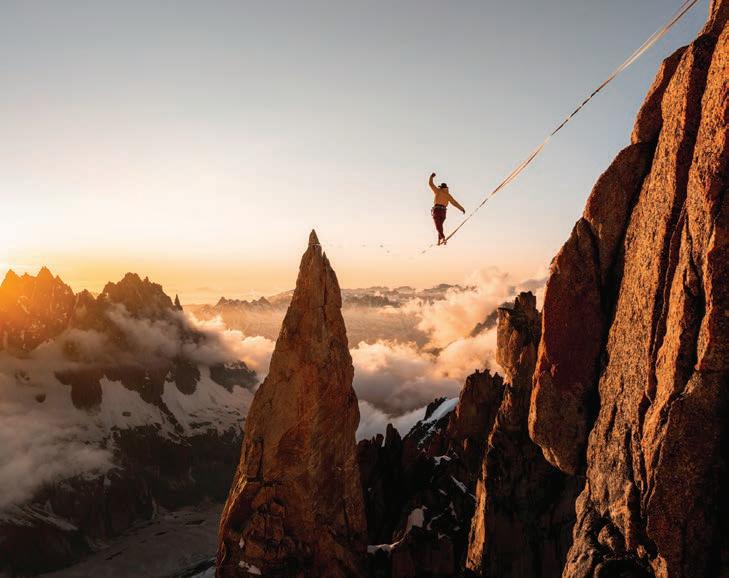
FILM
LIGHT MATTER
No Name Cinema
2013 Pinon St., nonamecinema.org
The experimental film and media arts festival Light Matter has become “a major East Coast showcase for experimental film and video.” Curator James Hansen constructs eccentric programs showcasing emerging and established artists.
7:30 pm, $5-$15
THE PEASANTS
Center for Contemporary Arts
1050 Old Pecos Trail, (505) 982-1338
The story of Jagna, a young woman determined to forge her own path within the confines of a 19th century Polish village. 11 am, $13
MUSIC
CARSON BARRY TRIO
The Mine Shaft Tavern
2846 Hwy. 14, Madrid, (505) 473-0743
Folk tunes.
5 pm
CHARLES TICHENOR
Los Magueyes Mexican Restaurant
31 Burro Alley, (505) 992-0304
Piano tunes and lyrics.
6-9 pm
DJ DMONIC & DYNAMITE
SOL
Boxcar
133 W Water St., (505) 988-7222
DJ DMonic turns the tables every first Friday of the month. 10 pm, $10
JAMES EMERY: INSIDE OUTLIER
Jean Cocteau Cinema








ST. RANGE
The Mine Shaft Tavern 2846 Hwy. 14, Madrid, (505) 473-0743
Desert rock jams. 8 pm
TGIF CONCERT SERIES:
DANIEL SCHWAB
First Presbyterian Church 208 Grant Ave., (505) 982-8544
Clarinetist Schwab plays “4:33” by John Cage and “Suite No. 1, for solo cello” by JS Bach.
5:30 pm
TERRY DIERS
Boxcar
133 W Water St., (505) 988-7222
Blues, rock and funk tunes. 6-8 pm
THE JAKES
Tiny’s Restaurant & Lounge 1105 S St. Franics Drive, (505) 983-9817
Classic rock. 8-11 pm
ZYDECO SQUEEZE BAND
CHOMP Food Hall 505 Cerrillos Road, Ste. B-101, chompsantafe.com
Laying down some fun zydeco tunes, originals and adapted pop songs. 7-9 pm
THEATER
TEATRO PARAGUAS
PRESENTS: MARIANA PINEDA
Teatro Paraguas 3205 Calle Marie, (505) 424-1601
A historical play about a woman executed for sewing a flag opposing King Ferdinand VII. 7:30 pm, $15-$25
WORKSHOP
418 Montezuma Ave., (505) 466-5528
A CD release party with a blend of guitarist Emery’s interpretations of jazz classics and original compositions. 7-9 pm, $28-$64
LENSIC PRESENTS TAJ MAHAL QUARTET AND SONA JOBARTEH
Lensic Performing Arts Center 211 W San Francisco St., (505) 988-1234
A legend who transcended the blues by revealing its magnificent scope to the world. 7:30 pm, $55-$94
MARION CARRILLO
Cowgirl
319 S Guadalupe St., (505) 982-2565
Carrillo’s songs pull from his personal life to great comedic and heart-wrenching effect. 4 pm
ORANGE DOORS, LEAVE THE LIGHTS ON AND REGULAR HUMANS
GHOST
2889 Trades West Road, instagram.com/ghost_santafe
Psychedelic grunge group
Orange Doors performs with local noisy fun from Leave the Lights On and Regular Humans’ experimental folk.
8 pm, $10 suggested
FRIDAY POTTERY THROWDOWN
Paseo Pottery
1273 Calle de Comercio, (505) 988-7687
Live pottery demos, music and libations. Try your hand on the wheel, sign up for a class and show love for local nonprofits. 5-8 pm, $25
WHEEL THROWING OR HAND BUILDING POTTERY EXPERIENCE
Paseo Pottery
1273 Calle de Comercio, (505) 988-7687
Wheel-throwing students learn to create a variety of shapes. Hand-building students learn ancient techniques for building forms by hand. 3-5 pm, $125
ART OPENINGS
ASHTON THORNHILL: REFLECTIVE LIGHT (OPENING)
Vista Grande Public Library 14 Avenida Torreon, (505) 466-7323
Thornhill’s work captures the beauty of the Southwest in its landscapes and horizons. 1-3 pm
We’d love to hear from you. Call (505) 695-8537 or send notices via email to calendar@sfreporter.com.
Make sure you include all the pertinent details such as location, time, price and so forth. It helps us out greatly.
Submission doesn’t guarantee inclusion.
BUTTERFLY PINNING CLASS
The Crow’s Nest 518 Old Santa Fe Trail, Ste. 6, (505) 416-7049
Learn the art of pinning and preserving ethically sourced butterflies. Anatomy and the process of preparing specimens will also be covered. Students will press two of their own specimens with guidance.
6 pm, $80
TRADING FACES (OPENING)
Eye on the Mountain Art Gallery 222 Delgado St., (928) 308-0319
Artist Michael Godey presents all-new multimedia works including paintings, drawings and prints. At the reception, Godey will also perform live music.
5-8 pm
BOOKS/LECTURES
ARTIST IN CONVERSATION:
SIGNE STUART AND ART HISTORIAN MALIN WILSONPOWELL
Pie Projects
924B Shoofly St., (505) 372-7681
Art historian Wilson-Powell and artist Stuart discuss the occasions of Stuart’s 60-year retrospective at the South Dakota Art Museum.
4-5 pm
BLACKDOM, NEW MEXICO: THE SIGNIFICANCE OF THE AFRO-FRONTIER, 1900–1930
Santa Fe Public Library (Southside) 6599 Jaguar Drive, (505) 955-2820
Timothy E. Nelson presents on Blackdom, New Mexico, a Black township that lasted about 30 years. In his book, Nelson situates the township’s story where it belongs, along the continuum of settlement in Mexico’s Northern Frontier, and illuminates the efforts Black pioneers made to create a frontier boomtown. 2 pm
DANCE
34TH ANNUAL CHOREOGRAPHERS’ SHOWCASE
Railyard Performance Center
1611 Paseo de Peralta, (505) 982-8309
This annual event showcases the finest choreographers working in Northern New Mexico. Purchase tickets ahead of time; this show sells out quick.
7:30 pm, $20-$30
EVENTS
EL MERCADO DE EL MUSEO CULTURAL
El Museo Cultural de Santa Fe 555 Camino de la Familia, (505) 992-0591
A weekend market filled to the brim with art, jewelry, books, herbal remedies, textiles, beads, furniture and more.
10 am-4 pm
LIVE WEAVING
DEMONSTRATIONS: A
TENUOUS THREAD
form & concept
435 S Guadalupe St., (505) 216-1256
A live demonstration of weaver Bhakti Ziek fiber craft as she weaves a large-scale tapestry.
10 am-5 pm
SANTA FE ARTISTS MARKET
At the Railyard, north of the Water Tower Market Street, (505) 310-8766
Local juried artists sell their fine art and crafts.
7 am-noon
THE PSYCHOLOGY OF SERIAL KILLERS
Lensic Performing Arts Center 211 W San Francisco St., (505) 988-1234
A touring masterclass diving deep into the darkest and most thought-provoking of subjects. How does an ordinary neighbor become a mass murderer?
7:30 pm, $35-$55
FILM
RIGHT IN THE EYE
Center for Contemporary Arts
1050 Old Pecos Trail, (505) 982-1338
A live movie-concert based on Georges Méliès’s films, created by Jean-Francois Alcolea.
1:30 pm and 7pm, $20
MUSIC
BOB MAUS BLUES & SOUL
Inn & Spa at Loretto 211 Old Santa Fe Trail, (505) 988-5531
Maus plays classic tune-smiths. 6-9 pm
CW AYON
Mineshaft Tavern 2846 Hwy 14 , Madrid, (505) 473-0743
Get ready to hear some blues! 8 pm
CHARLES TICHENOR
Los Magueyes Mexican Restaurant 31 Burro Alley, (505) 992-0304
Piano tunes and lyrics. 6-9 pm

JOHNNY LLOYD
Nuckolls Brewing Co. 1611 Alcaldesa St., nuckollsbrewing.com
Country favorite Lloyd performs for happy hour. 4-6 pm
ONE MORE SILVER DOLLAR
The Mine Shaft Tavern 2846 Hwy. 14, Madrid, (505) 473-0743
An Allman Brothers cover band. 3 pm
PAT MALONE QUARTET
Paradiso
903 Early St., (505) 577-5248
Malone and his crew play elegant jazz with a blues heart. 7:30-10 pm, $10-$20
PAUL GONZALES QUARTET
Club Legato
125 E Palace Ave., (505) 988-9232
Celebrate Albuquerque jazz trumpeter Paul Gonzales, alongside Bob Fox on piano, Cyrus Campbell on bass and John Trentacosta on drums.
7 pm, $30-$35
STANLIE KEE & STEP IN TRIO Cowgirl
319 S Guadalupe St., (505) 982-2565
Diné guitarist Kee heads a blistering trio of seasoned electric blues musicians.
1-3 pm
¡VOCES UNIDAS!
St. Francis Auditorium at the New Mexico Museum of Art 107 W Palace Ave., (505) 476-5072
A concert highlighting creative exchange between students from Florida’s FIU Wertheim School of Music and the Young Voices of Santa Fe Opera. 2 pm
TEATRO PARAGUAS
PRESENTS: MARIANA PINEDA
Teatro Paraguas 3205 Calle Marie, (505) 424-1601
A historical play about a woman executed for sewing a flag opposing the tyrannical rule of King Ferdinand VII. 7:30 pm, $15-$25
WORKSHOP
ELEMENTAL COLLAGE
Meow Wolf
1352 Rufina Circle, (505) 395-6369
Explore the power and significance of the four elemental forces (earth, fire, water and air) through visualization and collage. Express the elements artistically, encouraging self-exploration in a contemplative way.
11 am, $45
INTRODUCTION TO MICRODOSING: EMBRACING TRANSFORMATIVE PROCESSES
Best Daze (Palace)
128 W Palace Ave., (505) 585-4937
Co-authors Amy Wong Hope and Shin Yu Pai tell you how to maximize the microdosing and transformation process. (See 3 Questions, page 22.)
11:30 am-1:30 pm, $45
NUMEROLOGY: THE BUILDING BLOCKS OF SELF AWARENESS
Prana Blessings 1925 Rosina St., (505) 772-0171
Learn the mysteries behind the patterns that shape our lives. Noon-1:30 pm, $25
SUN/3
ART OPENINGS
SUNDAY DONUT EXPERIENCE WITH JOSH CLARK, OLIVER POLZIN AND MADELINE TONZI
Hecho a Mano
129 W Palace Ave., (505) 916-1341
Donuts, coffee, live music and a talk with artists from the Spring Dream exhibit.
11:30 am
RAILYARD ARTISAN MARKET Farmers’ Market Pavilion 1607 Paseo de Peralta, santafefarmersmarket.com/ railyard-artisan-market
About 40 local painters, jewelers, weavers and more. 10 am-3 pm
SORCERY AND MIGHT: BOARD GAME NIGHT CHOMP Food Hall
505 Cerrillos Road, Ste. B-101, chompsantafe.com
Board, tabletop roleplaying, card trading, and video games. 6 pm
WAYWARD COMEDY
MONTHLY IMPROV NIGHT
Tumbleroot Brewery & Distillery 2791 Agua Fría St., (505) 393-5135
A night of quick sketches and improv acting.
5-7 pm
ZANE LAMPREY
The Bridge at Santa Fe Brewing Co. 37 Fire Place, (505) 557-6182
Amazon Prime comedian Zane Lamprey performs as part of his THIRSTY! tour with all-new stories and material. 7:30-11 pm, $25-$40
MUSIC
CHAMBER MUSIC FOR PERIOD INSTRUMENTS
Immaculate Heart of Mary Retreat and Conference Center 50 Mount Carmel Road, (505) 988-1975
Music of the Baroque on recorders, flute, cello and harpsichord. 5:30-7 pm, $20-$50
BOOKS/LECTURES
AUTHOR EVENT WITH MARTHA BURNS
Garcia Street Books 376 Garcia St., (505) 986-0151
A reading, conversation and signing with Burns, author of historical fiction novel Across the Narrows 4:30-5:30 pm
EVENTS
CHESS AT CHOMP CHOMP Food Hall 505 Cerrillos Road, Ste. B-101, chompsantafe.com
Chess, great food and music.
6-8 pm
GEEKS WHO DRINK
Boxcar
133 W Water St., (505) 988-7222
It’s free to play and there are prizes. Seven rounds of quiz.
7:30 pm
EL MERCADO DE EL MUSEO CULTURAL
El Museo Cultural de Santa Fe 555 Camino de la Familia, (505) 992-0591
A weekend market filled to the brim with vendors selling art, jewelry, books, herbal remedies, textiles, beads, furniture and more. 10 am-4 pm
KARAOKE NIGHT Social Kitchen & Bar 725 Cerrillos Road, (505) 982-5952
Crash Romeo hosts karaoke. 6-9 pm
KARAOKE NIGHT
Boxcar 133 W Water St., (505) 988-7222
Karaoke hosted by Crash Romeo.
7 pm
NICK BROWER
El Rey Court 1862 Cerrillos Road, (505) 982-1931
Crooning and nostalgic music blending folk and orchestral influences.
7-9 pm
OLD-TIME JAM
Nuckolls Brewing Co. 1611 Alcaldesa St., nuckollsbrewing.com
Jam your favorite old-time fiddle tunes, led by Eric Carlson. 4-6 pm
ROSS BROTHERS BAND
The Mine Shaft Tavern 2846 Hwy. 14, Madrid, (505) 473-0743
A pop-rock band. 3 pm
SILVER SKY BLUES BAND
Cowgirl 319 S Guadalupe St., (505) 982-2565
Rock out to the blues! Noon
CONTINUED ON PAGE 23
28-MARCH 5,



The puritanical streak rippling through America has enabled gaps of knowledge on the effects of microdosing, but the grip is loosening. New Mexico lawmakers this year adopted a plan for new research on psilocybin, for example. It goes to show how dedicated researchers, educators, participants and scholars are working to not only demystify microdosing, but to arm people with the right information. Among them are writers Shin Yu Pai and Amy Wong Hope’s Small Doses of Awareness: A Microdosing Companion. The book and guided journal delves into Pai and Wong Hope’s experiences and expertise as a way to help new converts get the information they need should they start their microdosing journeys. Enter as well a pair of launch events to celebrate the book (6 pm
Friday, March 1. Free. The Ark, 133 Romero St., (505) 988-3709; 11:30 am-1:30 pm
Saturday, March 6. $45. Best Daze Palace, 128 W Palace Ave., (505) 585-4937). We spoke with Wong Hope to learn more. This interview has been edited for length and concision. (Alex De Vore)
You’re the expert: Can we quantify how well microdosing seems to be helping people yet, or is it too early?
It is too early right now, but at least what the research is showing is that microdosing is inconsistently helpful. We have to remember there are all these controlled variables to impose in order for it to be reliable and validated. The issue with microdosing is that it’s more of a subjective personal practice that people engage in, and when they do anecdotal, qualitative research where people are microdosing out of their homes versus coming into a lab… they don’t really see big effects with those groups. I suspect possibly people don’t carry through with a very long protocol in a research study with a lab, because they have to do it every three days.
It’s also very hard to gather the data, because to do a psych experiment requires an inordinate amount of review by an
internal review board as well as that it has to be cleared with the FDA and DEA because psychedelics such as psilocybin are not federally legal.
What do you see as some of the obstacles for people interested in microdosing?
I think the first one is: Where are people going to get their microdose substances, and what are they? Are they legal where you are? If you’re in New Mexico, they aren’t yet. It’s legal to grow mushrooms, but not legal to dry them or distribute them.
Another thing is people’s expectations of what microdosing is going to do for them. I would say microdosing…requires a subtle and nuanced ability to [be mindful], so you can be aware of the subtle shifts that are happening. It requires or calls for someone to be really committed to their integration. People think psychedelics—because there is so much out there, like the Michael Pollan series and book; the research headlines we’re seeing every other day in mainstream media—it can sometimes propagate this idea that psychedelics alone are panaceas for trauma and depression. I’m here to educate so people don’t harm themselves.
I’m not here to advocate for everybody using psychedelics, but they are a catalyst. And they can do things like increase our neuroplasticity. Is that any different than anybody who takes an antidepressant? But they have to take care of what’s happening in their lives. When I do trauma therapy with clients, they’re so insightful, but what does it take to take that insight and really work it into the soil and really nurture it and water it? The psychedelics can be a catalyst or an aid, but each human being is still responsible for doing their work.
Does New Mexico have programs and/ or facilities for folks curious about microdosing?
Right now I’m teaching a psychedelic studies certificate program at Southwestern College—a one-and-a-half-year program where I teach a one-weekend course every quarter for a total of six classes, and I get a really interesting demographic range. Somewhere under half are students at the college who are studying to become master’s level counselors, and some are practicing clinicians who are very seasoned. And I’m really excited I have such a strong demographic of practicing clinicians, because it’s telling me they want to learn more. Right now there are research experiments happening at University of New Mexico using psilocybin. UNM had the first DMT experiment run by Dr. Rick Strassman in the ‘90s, and that’s really where the psychedelic renaissance started. If people want to learn on their own, there are programs, there’s a lot on YouTube and in the podcast world and there are wonderful organizations putting out free content.
THEATER
CHARLOTTE’S WEB
Lensic Performing Arts Center
211 W San Francisco St., (505) 988-1234
Based on E.B. White’s loving story, Charlotte’s Web tells the tale of a friendship between a pig named Wilbur and a little spider named Charlotte. This version includes bluegrass music and stunning set design.
3 pm, $15-$18
TEATRO PARAGUAS
PRESENTS: MARIANA PINEDA
Teatro Paraguas
3205 Calle Marie, (505) 424-1601
A historical play about a woman executed for sewing a flag opposing King Ferdinand VII. 2 pm, $15-$25
WORKSHOP
CARTOMANCY CARD CLASS
Cake’s Cafe
227 Galisteo St., (505) 303-4880
Join local cartomancy author Ana Cortez to learn and practice card reading. 2-4 pm
BOOKS/LECTURES
A VOICE FOR THE VOICELESS:
30 YEARS OF SERVICE FOR THE WILD
Hotel Santa Fe
1501 Paseo de Peralta, (505) 982-1200
John Horning, former WildEarth Guardians executive director, journeys from a childhood of cultivating an appreciation for the solace of wild spaces to a life of environmental advocacy.
6 pm, $20
EVENTS
COVID-19 MEMORIAL DAY
Santa Fe Plaza
63 Lincoln Ave., (505) 955-6200
An event held to remember all who have died, fallen ill or who continue to suffer from the impact of COVID-19.
Noon-1 pm
CHESS AT THE MOVIES
Violet Crown Cinema
1606 Alcaldesa St., (505) 216-5678
Chess, great food and movies.
6-9 pm
KIDS SING ALONG: QUEEN
BEE MUSIC ASSOCIATION
Queen Bee Music Association
1596 Pacheco St., (505) 278-0012
Music games and sing-alongs for toddlers and babies. 10:30 am
FILM
VIDEO LIBRARY CLUB
Jean Cocteau Cinema
418 Montezuma Ave., (505) 466-5528
Free films every Monday. 6:30-8:30 pm
MUSIC
GRANT TURNER
The Mine Shaft Tavern
2846 Hwy. 14, Madrid, (505) 473-0743
A local singer-songwriter.
5 pm
KARAOKE WITH CRASH!
Cowgirl
319 S Guadalupe St., (505) 982-2565
Start the week with karaoke. 7-10 pm
OSCAR BUTLER
Cowgirl
319 S Guadalupe St., (505) 982-2565
Enjoy originals from an acoustic guitarist/singer-songwriter.
4 pm
THEATER
YOUNG CREATORS PROJECT
Santa Fe Public Library (Southside) 6599 Jaguar Drive, (505) 955-2820
A free program teaching theater skills to youth aged 9-16. 3:45-5:30 pm
ART
ARTISTS-IN-RESIDENCE
WELCOME DINNER
Institute of American Indian Arts 83 Avan Nu Po Road, (505) 424-2351
Join IAIA Artists-In-Residence
Tamara Ann Burgh (Swede and Inupiaq-Kawerak) and Brian Walker II Z(Inupiat and Deg Hit’an) for dinner and experience their artistic processes. 5-7 pm
EVENTS
ARTIST THINK TANK:
WHAT’S UNIQUE ABOUT BEING A WOMAN IN THE ARTS?
Online, (505) 424-1140
An open table Zoom discussion with artists and interested parties. Register at wesst.org. 9-10 am, $10
SORCERY AND MIGHT: BOARD GAME NIGHT
Boxcar
133 W Water St., (505) 988-7222
Board, tabletop roleplaying, collectible card trading and video games. Join the discord: discord. gg/GCfZrNBr. 7 pm
MUSIC
EARLY EYES AND TRASH PANDA
Meow Wolf
1352 Rufina Circle, (505) 395-6369
A band from Minneapolis making pop music for the end of the world. Pulling from neopsychedelia, soul, indie rock and pop music, the band considers themselves to be post-genre.
(See SFR Picks, page 17.) 6 pm, $23
LATIN SINDUSTRY NIGHT
Boxcar
133 W Water St., (505) 988-7222
Music with DJ DMonic and a 10% discount for service industry workers.
10 pm
RYAN CHRYS
Cowgirl
319 S Guadalupe St., (505) 982-2565
Country and ‘70s-style rock.
4 pm
THE DOWNTOWN BLUES JAM Evangelo’s
200 W San Francisco St, (505) 982-9014
Blues music hosted by Brotha Love & The Blueristocrats. 8:30-11:30 pm
WORKSHOP
UNDERSTANDING YOUR MIND: DEVELOPING CONCENTRATION
Santa Fe Women’s Club 1616 Old Pecos Trail, (505) 983-9455
Participants learn how to identify and use five special parts of their minds. This session’s topic is: “why are we so distracted?”
6-7:30 pm
ART
5TH ANNUAL FORO FORUM MEMBERS SHOW
Foto Forum Santa Fe 1714 Paseo de Peralta, (505) 470-2582
More than 60 original photographic works from members.
A TENUOUS THREAD
form & concept
435 S Guadalupe St., (505) 216-1256
A globe-spanning textile history dating back 1,470 years with weaving encapsulating a lifetime dedication to fiber work.
AN INNOCENT LOVE: ANIMAL SCULPTURE ARTISTS OF NEW MEXICO
Canyon Road Contemporary Art 622 Canyon Road, (505) 983-0433
The cutest little animal sculptures you ever did see.
ANDREW DASBURG: SYMPHONIC DRAWINGS
Addison Rowe Gallery 229 E Marcy St., (505) 982-1533
A collection of Cubist artist Dasburg's Western landscape works from 1930s Taos.
BRAD OVERTON (OPENING)
Blue Rain Gallery
544 S Guadalupe St., (505) 954-9902
Realist painter Overton intentionally balances the sobriety of art with a touch of humor.
BROOKS WILLIAMS, TRANSCENDENT FIELDS
Aurelia Gallery
414 Canyon Road, (505) 501-2915
Williams’ works on paper, aluminum and lenticular emanate a surreal essence.
CONTINUED ON PAGE 25






CARMEN HERRERA: I’M
NOBODY! WHO ARE YOU?
SITE Santa Fe
1606 Paseo de Peralta, (505) 989-1199
Later works by abstract minimalist artist Herrera, originating from an Emily Dickinson poem.
FORBIDDEN RITUAL
As Above So Below Distillery 545 Camino de la Familia, (505) 916-8596
Learn about the history of Tiki and its contributions to craft cocktail culture at this pop-up until it ends March 3.
I SAY WITH MY FULL ESSENCE
Center for Contemporary Arts
1050 Old Pecos Trail, (505) 982-1338
Seven women artists whose practices address their histories through personal signifiers.
JAY BAILEY: EAST OF THE SIERRAS
Evoke Contemporary
550 S. Guadalupe St., (505) 995-9902
Bailey makes paintings and drawings unique to his time and place in the American West.
JOSÉ SIERRA: CHOLLA
GALÁCTICA
Gerald Peters Contemporary
1011 Paseo de Peralta, (505) 954-5700
Colorful twisted vessels resembling dramatic landscapes.
KNOWN POINTS
form & concept
435 S Guadalupe St., (505) 216-1256
Mixed-media landscape compositions titled alongside iconic figurative and abstracted prints.
LOUISA MCELWAIN: DISTANT THUNDER
Evoke Contemporary
550 S. Guadalupe St., (505) 995-9902
McElwain’s bold paintings of the American Southwest express her love of nature.
MARTIN FERREYRA: DIOSES Y GUERREROS
Hecho a Mano
129 W Palace Ave., (505) 916-1341
Ferreyra references clothing and tools of Aztec warriors and textiles of Oaxacans through printmaking, painting, sculpture, weavings and clothing.
MINOL ARAKI: WHERE BEAUTY DWELLS
LewAllen Galleries
1613 Paseo de Peralta, (505) 988-3250
An exhibition celebrating the work of Minol Araki (19282010), an industrial designer and accomplished Japanese ink painter in the ancient literati tradition who was renowned for masterfully blending East Asian brush painting traditions.
PINK NOISE
smoke the moon
616 1/2 Canyon Road, smokethemoon.com
Like pages torn from an eerily amorous storybook, Kate Stringer’s illustrations interlace together a world of feminized creatures, markings and graphic narrative.
ROGER EVANS: CREATURE COMFORT
Wild Hearts Gallery 221 B Hwy. 165, Placitas, (505) 867-2450
Evans's signature, caricatured animals express ideas about race, class, sex, age and more, often poking fun at the social order.
SIN ROPA: A VALENTINE'S DAY NUDE DRAWING SHOW
Blue Rain Gallery
544 S Guadalupe St., (505) 954-9902
Intimate nude drawings offering a unique perspective into artist Erin Currier’s ability to capture the essence of her subjects.
THE MANY FACES OF...
ROBERT DAUGHTERS
Meyer Gallery
225 Canyon Road, (505) 424-9463
A retrospective filled with rare paintings, drawings and sculptures from late landscape artist Daughters, known for a painting technique known as “cloisonnism” causing his subjects to vibrate with movement.
THE MOVIES
Monroe Gallery of Photography 112 Don Gaspar Ave., (505) 992-0800
An exhibition featuring photographs from classic films of the 20th century. Over time, photographs from classic movies have developed historical and cultural importance.
TANIA POMALES: GHOSTS IN THE MACHINE
Keep Contemporary
142 Lincoln Ave., (505) 557-9574
Jersey-based Puerto Rican artist Pomales specializes in surreal oil works, juxtaposing bright color palettes with darker motifs.
TENDING SOIL
Martinez Studio
223 1/2 Canyon Road, (920) 288-7157
Lila Steffan works with foraged plant and mineral pigments in an exhibition of her work on handmade paper and recycled fabric, balancing abstraction with close observation of nature.
THE LOVE SHOW smoke the moon
616 1/2 Canyon Road, smokethemoon.com
A glimmering nine-person group show on love including pastel palettes, oil and polaroid paintings and ceramic sculptures.
TONY DE LUZ: SAINTS AND SINNERS
Blue Rain Gallery
544 S Guadalupe St., (505) 954-9902
Paying homage to vintage Americana, blending the glow of neon signs with the wistful nostalgia of old cars and the untamed spirits of motorcycles.
TRUE COLORS
LewAllen Galleries
1613 Paseo de Peralta, (505) 988-3250
An exhibition of color abstraction featuring rich, multi-layered surfaces of color that draw attention to the expressive qualities of each artist’s work.
WILLIAM REYNOLDS:
SHAZAM!
Pie Projects
924B Shoofly St., (505) 372-7681
Honoring the life and art of Reynolds with paintings from his years in the Himalayas, some of his Bar Code portraits and works from close artist friends.
WOMEN SPIRIT 2024
art is gallery santa fe 419 Canyon Road, (505) 629-2332
Celebrating the gallery's women artists with fine art, fiber art, jewelry and weavings.

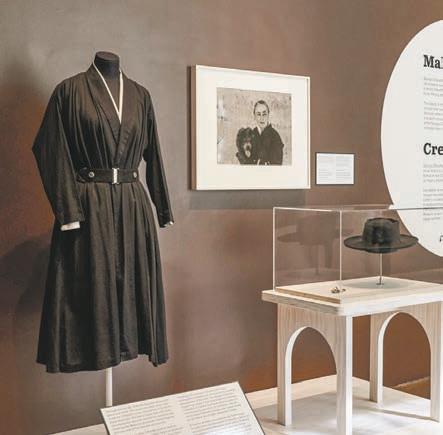
NEW MEXICO HISTORY
MUSEUM
113 Lincoln Ave., (505) 476-5200
The Santos of New Mexico. Miguel Trujillo and the Pursuit of Native Voting Rights. EnchantOrama! New Mexico Magazine Celebrates 100. Silver and Stones: Collaborations in Southwest Jewelry.
10 am-5 pm, Sat-Thurs, 10 am7 pm, Fri; $7-$12, NM residents free 5-7 pm first Fri. of the month
MUSEUM OF SPANISH
COLONIAL ART
750 Camino Lejo, (505) 982-2226
Lowrider Bike Club. Generations of Imagination: What Lies Behind the Vision of Chimayo Weavers.
1 -4 pm, Wed-Fri, $10, children free
NEW MEXICO MUSEUM OF ART
107 W Palace Ave., (505) 476-5063
GEORGIA O’KEEFFE MUSEUM
217 Johnson St., (505) 946-1000
Making a Life. Rooted in Place.
10 am-5 pm, Thurs-Mon, $20 (under 18 free)
IAIA MUSEUM OF CONTEMPORARY
NATIVE ARTS
108 Cathedral Place, (505) 983-8900
Womb of the Earth: Cosmovision of the Rainforest. Inuk Silis Høegh: Arctic Vertigo. Indigenous Presence, Indigenous Futures. The Stories We Carry. Our Stories.
10 am-4 pm, Wed-Sat, Mon
11 am-4 pm, Sun, $5-$10
Free Admission every Friday
MUSEUM OF ENCAUSTIC ART
18 County Road 55A, (505) 424-6487
Permanent collection.
11 am-5 pm, Fri-Sun, $10 (18 and under free)
MUSEUM OF INDIAN ARTS AND CULTURE
710 Camino Lejo, (505) 476-1269
Down Home. Here, Now and Always. Horizons: Weaving Between the Lines with Diné Textiles.
10 am-5 pm, $7-$12, NM residents free first Sunday of the month
MUSEUM OF INTERNATIONAL FOLK ART
706 Camino Lejo, (505) 476-1204
Ghhúunayúkata / To Keep
Them Warm: The Alaska Native Parka. La Cartonería Mexicana / The Mexican Art of Paper and Paste. Protection: Adaptation and Resistance. Multiple Visions: A Common Bond. 10 am-5 pm, $3-$12, NM residents free first Sunday of the month
Selections from the 20th Century Collection. Out West: Gay and Lesbian Artists in the Southwest 1900-1969. To Make, Unmake, and Make Again. Ways of Seeing: Four Photography Collections. 10 am-5 pm, Sat-Thurs, 10 am7 pm, Fri; $7-$12, NM residents free 5-7 pm every Fri. May-Oct.
POEH CULTURAL CENTER
78 Cities of Gold Road, (505) 455-5041
Di Wae Powa. Nah Poeh Meng. 10 am-5 pm, Mon-Fri, $7-$10
VLADEM CONTEMPORARY
404 Montezuma Ave., (505) 476-5602
Shadow and Light
10 am-5 pm, Sat-Thurs, 10 am7 pm, Fri; $7-$12, NM residents free 5-7 pm every Fri. May-Oct.
WHEELWRIGHT MUSEUM OF THE AMERICAN INDIAN
704 Camino Lejo, (505) 982-4636
Masterglass: The Collaborative Spirit of Tony Jojola. Pathfinder: 40 Years of Marcus Amerman. Journeying Through the Archives of the Wheelwright Museum. 10 am-4 pm, Tues-Sat, $10

We are in a real pickle, New Mexico.
1 FOOD BANK. 9 COUNTIES.
40,000 HUNGRY PEOPLE. WE NEED YOU.
DONATE, ADVOCATE, OR VOLUNTEER TODAY.


High food and fuel prices, increased demand, and fewer donations mean your food bank needs support now more than ever.
Visit thefooddepot.org.

Understanding the histories that shape our lives isn’t easy when so much of what we learn in school and history books conceals, misrepresents or downright fabricates the truth. But gaining that understanding provides the key to being in the right relationships with the land, each other and ourselves—an idea that’s central to Deborah Jackson Taffa’s new memoir, Whiskey Tender (HarperCollins, Feb. 27).
Taffa (Quechan and Laguna Pueblo) is the director of the MFA in Creative Writing at the Institute of American Indian Arts, and a recent recipient of a $25,000 Creative Writing Fellowship from the National Endowment for the Arts. Her first foray into memoir, Whiskey Tender, excavates the legal, political and historical forces that intimately shaped her family’s life, following Taffa from the California Quechan (Yuma) reservation, to Farmington in Navajo territory, to Yellowstone National Park for her first job after leaving home.
Taffa writes: “A father’s job was to control the pace of the world’s wounding, to dole out the pain in slightly bigger doses over time so that his kids would learn not to break under pressure.”
That’s the role Taffa takes as narrator of her own story, meting out the beauty, heartbreak, humor and anger to her readers as tenderly as a loving parent.
She always knew she wanted to tell the story of her own childhood as a mixedtribe Native girl in the context of broader Indigenous histories, she tells SFR. This story bridges a gap in the American literary canon.
“I’ve never seen a comprehensive coming-of-age memoir written by a Native person,” Taffa says. “They say you should write the book that you need, and for me, that’s the story of a Native kid growing up and leaving home.”
She reckoned with Quechan (Yuma) tribal traditions and beliefs regarding oral and recorded histories in writing Whiskey Tender, and acknowledges how the pressure for Indigenous cultures to assimilate in a violent, oppressive colonized world made her great-grandparents’, grandparents’ and even parents’ generations fiercely protective of their stories. But now, she says, things are beginning to change.
“I think we’re at this crucial moment in society when we’re seeing so many crises, like climate change,” Taffa says, “and I think that everyone can benefit from hearing Native stories and learning more about Native values.”
She recognizes her story shares common threads with thousands of Indigenous people, writing in Whiskey Tender that “so many people could tell this story, it is shocking how rarely it has been told.”
But Taffa lends the story her own specificity of language and rendering of
memory, her innate curiosity and intuition leading her to peel back the layers of missing and mis-information.
She had amassed decades of notes and hours of recorded interviews by the time she sat down to write, including notes from her time living on the Quechan reservation with her husband and kids in the late 1990s and early 2000s, when she would go to the Arizona Historical Society to read about tribal history and politics on microfiche. She spent time interviewing her great aunts, who had been involved in tribal governments and were welders during World War II, and recorded 14 hours of interviews with her parents.

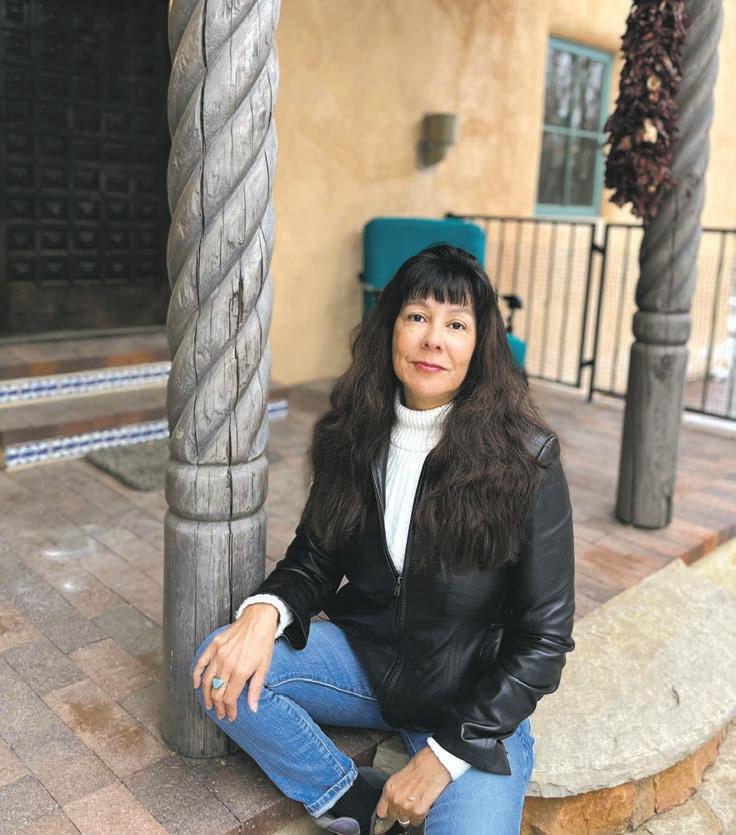
When she came to IAIA in 2021, she realized she’d lucked into one of her greatest resources: the college’s library, which houses one of the best collections of Native histories in the country. Taffa’s office is just across the Dance Circle from the library, and it was there that she was able to confirm much of what she’d learned from family lore.
“When I went to the library I found all of this evidence that these memories were real—it was just incredible,” Taffa says. “It feels to me like my ancestors were watching out for me.”
Still, Whiskey Tender was “incredibly difficult to write,” she says, particularly in revisiting the trauma and racism of her childhood in Farmington. She aimed to distill complex histories into compelling, colloquial language so readers can enjoy the story while absorbing the history.
“I wanted it to go more towards [Reservation] Dogs,” Taffa says, “because otherwise you’re gonna get a lot of white academics who read the book and your own kids are gonna be bored by it.”
She recalls speaking with students at Haskell Indian Nations University about Whiskey Tender, which made her realize why she wrote it in the first place:
“The meaning of this entire thing for me is Native futures,” Taffa says. “If your family has struggles, it’s easy to imagine those struggles are some sort of moral failing on their part. If your schools don’t teach you your own history, you know something’s wrong, but you can’t understand—why can’t your family just pull themselves up by their bootstraps? Why do you feel so sad? Why is it so difficult? But when you gain a knowledge of history, you are so much more empowered to confront your life, because you understand how things came to be the way they are.”
No doubt film folk will liken cinematographer-turned director/screenwriter Sean Price Williams’ feature debut The Sweet East to an Alice in Wonderland/ Through the Looking Glass sort of thing (the latter is weirder than Wonderland, but then, so is this movie). And they’ll be right to a certain point, but it’s a bit more like The Odyssey in form.
Herein, high school-aged Lilian (Talia Ryder, Dumb Money) seemingly unwittingly finds herself thrust into the strange pockets of humanity that lurk beneath the crumbling veneer of modern America while on a class trip to Washington, DC. After that, while traipsing around who-knows-where, she runs across any number of bizarre fringe folk who exist in the liminal spaces between polite society.
The cast of come-and-go characters and factions— from a faux-poor punk poseur and a white supremacist academic to a pair of jargon-loving filmmakers and some sort of men’s cult in the farmland—each represents something stranger than the last. But Ryder’s take on Lilian presents a person who learns from her surroundings and uses those lessons to catapult herself along through sheer cleverness, making each encounter valuable in its own way.
Lilian is a bit of a cypher, and we can never be sure if she’s actively choosing to lie and finagle her way through her journey, or if she can’t help being some

sort of empty vessel who mimics thoughts and feelings. Ryder both charms and terrifies as the sometimes dead-eyed teen. She disappears completely into Lilian and subtly showcases the intricacies of her particular existence. Does she owe men who help her a goddamn thing? Is she just bored? Why is she so willing to simply go along with whatever situation next presents itself?
Like Lilian herself, those things remain a mystery throughout the film, but it’s still depressingly relatable, particularly when she hits flashes of exasperation or sadness or even nothingness. And it all begs a question: How the hell do we exist in relation to others and why do we pretend humankind isn’t just a bazillion weridos playing at house and war and art and activism and education?
Williams has thus far been known as a consistent collaborator of the Safdie filmmaker brothers (Uncuh Jaaaaaamz), but it’s cool to see him strike out on his own with something so unignorable. The Sweet East reads like a nauseating travel diary punctuated
by strong personalities, yet every time we lose the thread, Ryder’s Lilian keeps it grounded and enticing. Throw in short appearances from Ayo Edebiri (The Bear), Jacob Elordi (pretty much everything lately) and Simon Rex (Red Rocket) in what is easily the finest performance of his career, and we’ve really got something. If The Sweet East is Williams’ proof that he has ideas and abilities, his sophomore effort should be a real winner. Heads up, though, fans of clear-cut narrative? You might not wanna hang. The rest of you? This one will stick with you for days, and not just for the unexpected yet glorious musical moment in the opening act. The Sweet East plays at the CCA for one week only—March 1-7.
Directed by Wiliams With Ryder, Rex, Edebiri and Elordi Center for Contemporary Arts, NR, 104 min.
MADAME WEB
1 + GOOD FOR A LAUGH - TERRIBLE PLOT; TERRIBLE PERFORMANCES; TERRIBLE EVERYTHING
Superhero fatigue or no, Marvel Studios has at least crafted a formula that brings in box office bucks. Even when we don’t love the movies, they’ve become reliable rainy day schlock full of fun explosions and silly jokes. They’re fast food for the most part.
With the newly released Madame Web, however, Sony-owned Columbia Pictures has so bungled its access to the Spider-Man license and its stable of characters—oh, did you not know that Marvel doesn’t actually own Spidey, and that those Tom Holland-led movies are the result of a 2015 deal all but signaling Sony doesn’t much know how to make it work?—that one wonders if the company might just throw in the towel and leave the franchise to literally anyone else. It couldn’t possibly get worse.
In Madame Web, Dakota Johnson plays Cassandra Web, a New York City-based EMT whose mother died during childbirth in the Peruvian Amazon while looking for magic spiders (seriously). Cut to 30 years later and Cassie doesn’t much like people, save her partner Ben Parker (as in, Uncle Ben, but, like, Peter Parker’s uncle, not the rice guy; Adam Scott) and she certainly won’t be roped into anything resembling a relationship, platonic or otherwise.
But when she technically dies for a sec during an emergency call, Cassie gains the ability to see a couple minutes into the future. Her new powers thrust Cassie into a caretaker position with a trio of teen
ladies (Sydney Sweeney, Isabela Merced and Celeste O’Connor) who might just get their own spider-adjacent powers someday if her visions are to be believed. Chaos ensues for two terrible, horrible, no-good, very bad hours while we wonder if Cassie’s powers will help her thwart tragedies or only lead to their inevitable outcomes—y’know, like in all mythology? Just kidding, no one wondered that so much as they wondered when the movie would end.
The only thing more absurd than Johnson’s mind-numbingly emotionless performance as Madame Web (how lucky that her last name denotes spider stuff!) is the script from writers Matt Sazama, Burk Sharpless and Claire Parker. The villain in the film (a hysterically cartoony only not fun Tahar Rahim, Napoleon) has visions, too, and thinks those would-be Spider-Gals might kill him one day if he doesn’t kill them first. He repeatedly says he won’t let them destroy what he’s built, only we never learn what that is. Is it a company? A lego castle? Rich friendships? No one knows, and Madame Web isn’t telling.
And the dimensionless villain makes up the least of our problems. In fact, it wouldn’t be shocking if director SJ Clarkson (who mostly has TV credits under her belt) came out to say the suits at Sony got their grubby mitts onto this movie. There is otherwise no excuse. Madame Web is for the ironic likers and the people who can’t look away from a car crash—everyone else should just forget it exists like Dakota Johnson is likely doing right now, even as we speak. (ADV)
Regal, Violet Crown, PG-13, 116 min.
3 + SOBERANO; NEWTON HAS A CERTAIN CHARM - NOT FUNNY; WEAK WRITING
Juno screenwriter Diablo Cody returns with Lisa Frankenstein, also Zelda Williams’ (yes, Robin’s daughter) directorial debut and a bizarre mish-mash of superior films that smacks of millennials telling the zoomers that they (we?) are still hip and groovy while somehow forgetting to make a film worth watching.
Ant Man and the Wasp: Quantumania star Kathryn Newton here plays Lisa, a high school-aged dork with goth leanings circa 1989 whose father remarried a little too quickly after her mother died, forcing them into a new home in a new town just as Lisa hits her senior year. There, Lisa’s stepmother (a cheesybut-in-a-bad-way Carla Gugino) criticizes her every move while her father stands by cluelessly. School is a living hell, too, and Lisa’s only respites come from her stepsister Taffy (Liza Soberano, who is easily the funniest—read, only reliably funny—performer in the movie) and a weird cemetery in the woods called Bachelor’s Grove where only single dudes ever got buried in the 1800-somethings.
Presenting a rather reductive and borderline mean look at ‘80s goth culture, Cody here has Lisa reading poetry to a literal grave and even wishing during a storm that she could be with one of the guys buried there. Said storm brings that dude, thereafter known as The Creature (Cole Sprouse, Riverdale), back to life, and he naturally starts killing anyone who wrongs Lisa to harvest their body parts
which, for whatever reason, slowly de-zombify him through the power of a magic tanning bed. Lisa goes way more goth; The Creature gets a new hand and ear culled from his murder victims; high school continues to suck.
Newton surely tries her best as the outcast Lisa, and even hits some funny-ish moments regarding insecurity and budding sexuality. Cody lands on a bit of witty dialogue a handful of times, but Lisa Frankenstein abounds with inexplicable moments— like the neighborhood couple who sits on their lawn in the dark while reading solely in service of exposition, or the weird way people just walk into other peoples’ homes unannounced.
Williams’ newcomer status shows in most of her stilted choices. Meanwhile, whoever was in charge of set design clearly forgot—or just plain didn’t know—that the 1980s were a lot more brown and beige than they were the bright teals and pinks and neons of the very early ‘90s. Lisa Frankenstein thus reads like a strange mix between the tone of Heathers without the cynical wit, Edward Scissorhands without the social commentary and that of the tragically underrated absurdity of 1993 zom-com My Boyfriend’s Back, only without the sincerity.
Cody and Williams make it nearly impossible to discern whether they’re attempting to deliver a message or not. If they are, they kind of dropped the ball. If not, and Lisa Frankenstein is just supposed to be a silly little comedy…well, better luck next time, Zelda.(ADV)
Violet Crown, Regal, 101 min., PG-13
35 Reno-to-Spokane dir.
36 “Knights of Cydonia” band
37 “La ___” (Debussy composition)
38 Just heated up?
42 “Gangnam Style” performer
43 Letter from Homer
44 Walk like a zombie
45 Some DVD players
47 “And Still ___” (Maya Angelou book)
48 Like home renovation shows that overdo the wood siding?
52 Video game character with his own Maker
53 Prefix with dextrous
54 Proton’s place
58 Signing off on
59 Overwhelming victory
60 Donated
61 Talkative, slangily
62 ___-Tiki (Heyerdahl craft)
63 Shiraz location
1 Nursery rhyme jumper
2 “... but few ___ chosen”
3 “___ MisÈrables”
4 Like some instincts
5 Use a tent
6 High points
7 With “The,” ‘90s British altrock band named for an American novel character
8 Sunday shopping restriction
9 Ladder components
10 “Because Freedom Can’t Protect Itself” org.
11 “Days Are Gone” band
12 Italian family related to the Borgias
14 Battle-trained canine
20 Poker starter
Matt Jones
21 Chinese tennis star with a very short name in English
22 Mall units
23 Meager
25 Playful rascal
26 Home of the Boston Red Sox
28 Examines, as depths
29 Brazilian supermodel B¸ndchen
30 Napped material
32 Pete Davidson’s show, once
36 Mentor in “The Karate Kid”
38 Vocabulary coinage, e.g.
39 10,900-foot European peak
40 “Try to detect it! It’s not too late!” song
41 Publisher of Modern Maturity
45 They’re earned on “Press Your Luck”
46 “Li’l Abner” creature that looks like a white blob with a mustache
48 Air impurifier
49 Maori dance popularized by some New Zealand rugby teams
50 Part of the eye around the pupil
51 Have ___ in the oven
55 Viscous goo
56 Eggs in labs
57 “___ Behaving Badly”




ARIES (March 21-April 19): In my astrological estimation, the coming weeks will be an ideal time for you to declare amnesty, negotiate truces, and shed long-simmering resentments. Other recommended activities: Find ways to joke about embarrassing memories, break a bad habit just because it’s fun to do so, and throw away outdated stuff you no longer need. Just do the best you can as you carry out these challenging assignments; you don’t have to be perfect. For inspiration, read these wise words from poet David Whyte: “When you forgive others, they may not notice, but you will heal. Forgiveness is not something we do for others; it is a gift to ourselves.”
TAURUS (April 20-May 20): Many of you Tauruses have a robust capacity for doing diligent, effective work. Many of you also have a robust capacity for pursuing sensual delights and cultivating healing beauty. When your mental health is functioning at peak levels, these two drives to enjoy life are complementary; they don’t get in each other’s way. If you ever fall out of your healthy rhythm, these two drives may conflict. My wish for you in the coming months is that they will be in synergistic harmony, humming along with grace. That’s also my prediction: I foresee you will do just that.
GEMINI (May 21-June 20): Many people choose wealthy entertainers and celebrity athletes for their heroes. It doesn’t bother me if they do. Why should it? But the superstars who provoke my adoration are more likely to be artists and activists. Author Rebecca Solnit is one. Potawatomi biologist and author Robin Wall Kimmerer. The four musicians in the Ukrainian band DahkaBrakha. Poet Rita Dove and novelist Haruki Murakami. My capacity to be inspired by these maestros seems inexhaustible. What about you, Gemini? Who are the heroes who move you and shake you in all the best ways? Now is a time to be extra proactive in learning from your heroes—and rounding up new heroes to be influenced by.
CANCER (June 21-July 22): Your homework assignment is to work on coordinating two issues that are key to your life’s purpose. The first of these issues is your fervent longing to make your distinctive mark on this crazy, chaotic world. The second issue is your need to cultivate sweet privacy and protective self-care. These themes may sometimes seem to be opposed. But with even just a little ingenious effort, you can get them to weave together beautifully. Now is a good time to cultivate this healing magic.
LEO (July 23-Aug. 22): If you don’t recognize the face in the mirror right now, that’s a good thing. If you feel unfamiliar feelings rising up in you or find yourself entertaining unusual longings, those are also good things. The voice of reason may say you should be worried about such phenomena. But as the voice of mischievous sagacity, I urge you to be curious and receptive. You are being invited to explore fertile possibilities that have previously been unavailable or off-limits. Fate is offering you the chance to discover more about your future potentials. At least for now, power can come from being unpredictable and investigating taboos.
VIRGO (Aug. 23-Sept. 22): I invite you to study the fine art of sacred intimacy in the coming weeks. Life’s rhythms will redound in your favor as you enjoy playing tenderly and freely with the special people you care for. To aid you in your efforts, here are three questions to ponder. 1. What aspects of togetherness might flourish if you approach them with less solemnity and more fun? 2. Could you give more of yourself to your relationships in ways that are purely enjoyable, not done mostly out of duty? 3. Would you be willing to explore the possibility that the two of you could educate and ripen each other’s dark sides?
LIBRA (Sept. 23-Oct. 22): Creativity teacher Roger von Oech tells how bandleader Count Basie asked a club owner to fix his piano. It was always out of tune. A few weeks later, the owner called Basie to say everything
was good. But when Basie arrived to play, the piano still had sour notes. “I thought you said you fixed it!” Basie complained. The owner said, “I did. I painted it.” The moral of the story for the rest of us, concludes von Oech, is that we’ve got to solve the right problems. I want you Libras to do that in the coming weeks. Make sure you identify what really needs changing, not some distracting minor glitch.
SCORPIO (Oct. 23-Nov. 21): Most of us have received an inadequate or downright poor education about love and intimate togetherness. Given how much misinformation and trivializing propaganda we have absorbed, it’s amazing any of us have figured out how to create healthy, vigorous relationships. That’s the bad news, Scorpio. The good news is that you are cruising through a sustained phase of your astrological cycle when you’re far more likely than usual to acquire vibrant teachings about this essential part of your life. I urge you to draw up a plan for how to take maximum advantage of the cosmic opportunity. For inspiration, here’s poet Rainer Maria Rilke: “For one human being to love another human being: that is perhaps the most difficult task entrusted to us, the ultimate task, the final test and proof, the work for which all other work is merely preparation.” (Translation by Stephen Mitchell.)
SAGITTARIUS (Nov. 22-Dec. 21): The myths and legends of many cultures postulate the existence of spirits who are mischievous but not malevolent. They play harmless pranks. Their main purpose may be to remind us that another world, a less material realm, overlaps with ours. And sometimes, the intention of these ethereal tricksters seems to be downright benevolent. They nudge us out of our staid rhythms, mystifying us with freaky phenomena that suggest reality is not as solid and predictable as we might imagine. I suspect you may soon have encounters with some of these characters: friendly poltergeists, fairies, ghosts, sprites, or elves. My sense is that they will bring you odd but genuine blessings.
CAPRICORN (Dec. 22-Jan. 19): Some studies suggest that less than half of us have best friends. Men are even less likely to have beloved buddies than the other genders do. If you are one of these people, the coming weeks and months will be an excellent time to remedy the deficiency. Your ability to attract and bond with interesting allies will be higher than usual. If you do have best friends, I suggest you intensify your appreciation for and devotion to them. You need and deserve companions who respect you deeply, know you intimately, and listen well. But you’ve got to remember that relationships like these require deep thought, hard work, and honest expressions of feelings!
AQUARIUS (Jan. 20-Feb. 18): Among all the zodiac signs, you Aquarians are among the best at enjoying a bird’s-eye perspective on the world. Soaring high above the mad chatter and clatter is your birthright and specialty. I love that about you, which is why I hardly ever shout up in your direction, “Get your ass back down to earth!” However, I now suspect you are overdue to spend some quality time here on the ground level. At least temporarily, I advise you to trade the bird’s-eye view for a worm’s-eye view. Don’t fret. It’s only for a short time. You’ll be aloft again soon.
PISCES (Feb. 19-March 20): In old Hawaii, the people loved their deities but also demanded productive results. If a god stopped providing worshipers with what they wanted, they might dismiss him and adopt a replacement. I love that! And I invite you to experiment with a similar approach in the coming weeks. Are your divine helpers doing a good job? Are they supplying you with steady streams of inspiration, love, and fulfillment?
If not, fire them and scout around for substitutes. If they are performing well, pour out your soul in gratitude.
Homework: What do you want to do but have not been doing it—for no good reason?
Newsletter.FreeWillAstrology.com
Go to RealAstrology.com to check out Rob Brezsny’s Expanded Weekly Audio Horoscopes and Daily Text Message Horoscopes . The audio horoscopes are also available by phone at 1-877-873-4888 or 1-900-950-7700.

“Hi Alex, you were right about everything ”
Client, Santa Fe, NM For more information call 505-982-8327 or visit www.alexofavalon.com.

Embrace
with Michele Renae, Spiritual Counselor. Specialties: personal growth, life transitions, and inner healing.
Book your free 15 minute Inquiry Call michelerenaespiritualcounselor.com

Envision Your 2024
When you’re not clear, it’s hard to do or feel well. In 2024, you can decide to resource yourself from the inside out. Finding the light of your path and the confidence to walk somewhere truly new. Abstract Therapie is Intuitive Coaching for Creatives, Empaths and Entrepreneurs.
Book a Discovery Call with Coach Ryan; text 505-231-8036 or access the code below. abstracttherapie.com



Understanding Your MindDeveloping Concentration
Classes meet 6:00-7:30p at the Santa Fe Women’s Club, 1616 Old Pecos Trail, Santa Fe Moment by moment, we experience our world through our mind. Yet we often don’t even know what our mind is. In this series, we will get to know our mind on a deeper level and learn to experience more and more peaceful states of mind, which is our natural state once distractions subside. By improving our concentration, we can then choose to focus on an object, a thought or a state of mind that brings peace and clarity into our daily life and stop concentrating on the thoughts and mental patterns we are familiar with. By understanding our mind on this basic, but profound level, we can begin to gain more control over our mind, rather than our mind controlling us.
Topics Include:
March 5 - Why are we so
Distracted?
March 12 - Holding on to What Matters
March 19 - Learning Not to Forget: Improving Mindfulness
March 26 - The Importance of Good Concentration
April 2 - The Practice of Increasing our Wisdom
About the Teacher
Practice How Your FEMALE CREATIVE ENERGY Heals Your Life • In this intuitive experience, be guided in meditation to ground safely into the body and restore your life force • Find out what’s so capable, freeing and unique about your female energy • Develop more of your intuition • Let go of old relationship patterns • Remove other peoples’ pain and judgment to free up more choice, agency, and miracles for yourself • Increase your well being and creative expression. Use “Series/$200” button at deeprootsstudio.com • Zoom • 4 Fridays, March 1, 15, 22 & 29 @3:00-4:45pm
HELP YOUR NEIGHBORS BY BECOMING AN ESL or LITERACY TUTOR. Literacy Volunteers of Santa Fe’s 10-hour training prepares volunteers to tutor adults in English as a Second Language (ESL) The ESL new tutor orientation will be held online on Thursday, April 11th, from 4 to 6 p.m., and the in-person training will be on Friday & Saturday, April 12th and 13th from 9 a.m. to 1 p.m. at SFCC. A registration meeting and a 2-hour follow-up workshop are also included. For more information, please call 505-428-1353 or visit www.lvsf.org to complete an application. No experience or second language necessary!
FIRST JUDICIAL DISTRICT COURT
COUNTY OF SANTA FE STAFE OF NEW MEXICO NO. D-101-PB-2023-00337
IN THE MATTER OF THE ESTATE OF KEVIN PATRICK GRANDINETTI, Deceased.
NOTICE TO CREDITORS
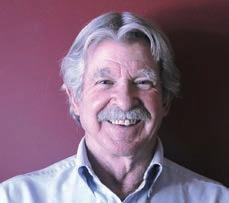
Gen Khyenwang is the Resident Teacher of Kadampa Meditation Center New Mexico. She is a close disciple and student of Venerable Geshe Kelsang Gyatso and has been practicing and teaching under his guidance for many years. The teachings she shares are clear, heartfelt and extremely practical for modern life. Gen Khyenwang is an inspiring example of a contemporary Buddhist practitioner and is known for her warmth and sincerity, putting time-tested teachings into practice in daily life.
Registration
There is no need to pre-register for this drop-in class. Suggested donation is $10 but no one is turned away for lack of funds. Please call (505) 292-5293 or contact admin@meditationinnewmex ico.org if you have any questions.
NOTICE IS HEREBY GIVEN that Jami Gressman has been appointed as Personal Representative of this estate. Any person having a claim against this estate is required to present his/her claim within four (4) months after the state of the first publication of this Notice or his/her claim will be forever barred. Claims must be either (a) presented by mail or in person to the Personal Representative at the offices of the attorneys for the estate (Wilcox, Myers, & Jones, P.C., Post Office Box 70238, Albuquerque, New Mexico 87197, or 320 Osuna Road NE, Suite C-2, Albuquerque, New Mexico 87107, Attn: Jeffrey J. Myers, Esq.), or (b) filed with the First Judicial District Court, Santa Fe County, 225 Montezuma Avenue, Santa Fe, New Mexico 87501 or P.O. Box 2263, Santa Fe, New Mexico 87504-2268.
DATED: February 13, 2024
/s/ JAMI GRESSMAN WILCOX, MYERS, & JONES P.C. Attorneys for the Estate /s/ JEFFREY D. MYERS, M.S.,
of the attorneys for the estate
(Wilcox, Myers, & Jones, P.C., Post Office Box 70238, Albuquerque, New Mexico 87197, or 320 Osuna Road NE, Suite C-2, Attn: Madison R. Jones, Esq.), or (b) filed with the First Judicial District Court, Santa Fe County, Post Office Box 2268, Santa Fe, New Mexico 87501, or 225 Montezuma Avenue, Santa Fe, New Mexico 87501.
Dated: 12/4/2023
Todd J. Schroeder
/s/ Todd J. Schroeder
Dated: Troy M. Schroeder /s/ Troy M. Schroeder WILCOX, MYERS, & JONES, P.C. Attorneys for the Estate Madison R. Jones /s/ Madison R. Jones Post Office Box 70238 Albuquerque, New Mexico 87197 (505) 554-1115
STATE OF NEW MEXICO
COUNTY OF SANTA FE
FIRST JUDICIAL DISTRICT No. D-101-CV-2020-02425
Gina Bazan, Plaintiff v. GILBERT SANDOVAL, ALBERT G. TALBOT, BRET M. HALE, AND HALESTONE, LLC., Defendants.
NOTICE OF PENDENCY OF ACTION AGAINST BRET M. HALE, INDIVIDUALLY AND AS AGENT FOR HALESTONE, LLC. You are hereby notified that the above-named Plaintiff has filed a civil action against you in the above-entitled Court and case. The general object thereof being to recover damages from an accident that occurred on or about August 23, 2019; Unless Bret M. Hale and Halestone, LLC, serve a pleading in response to the Complaint in said cause on or before thirty (30) days after the last publication date of will be entered against you; and the attorneys for Plaintiff are Dennis K. Wallin, and Tyson Logan of The Spence Law Firm NM, LLC, located at 1600 Mountain Rd NW, Albuquerque, NM 87104. They may be reached by telephone at (505) 832-6363.








